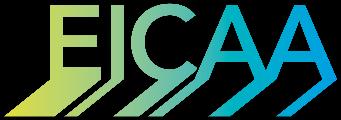
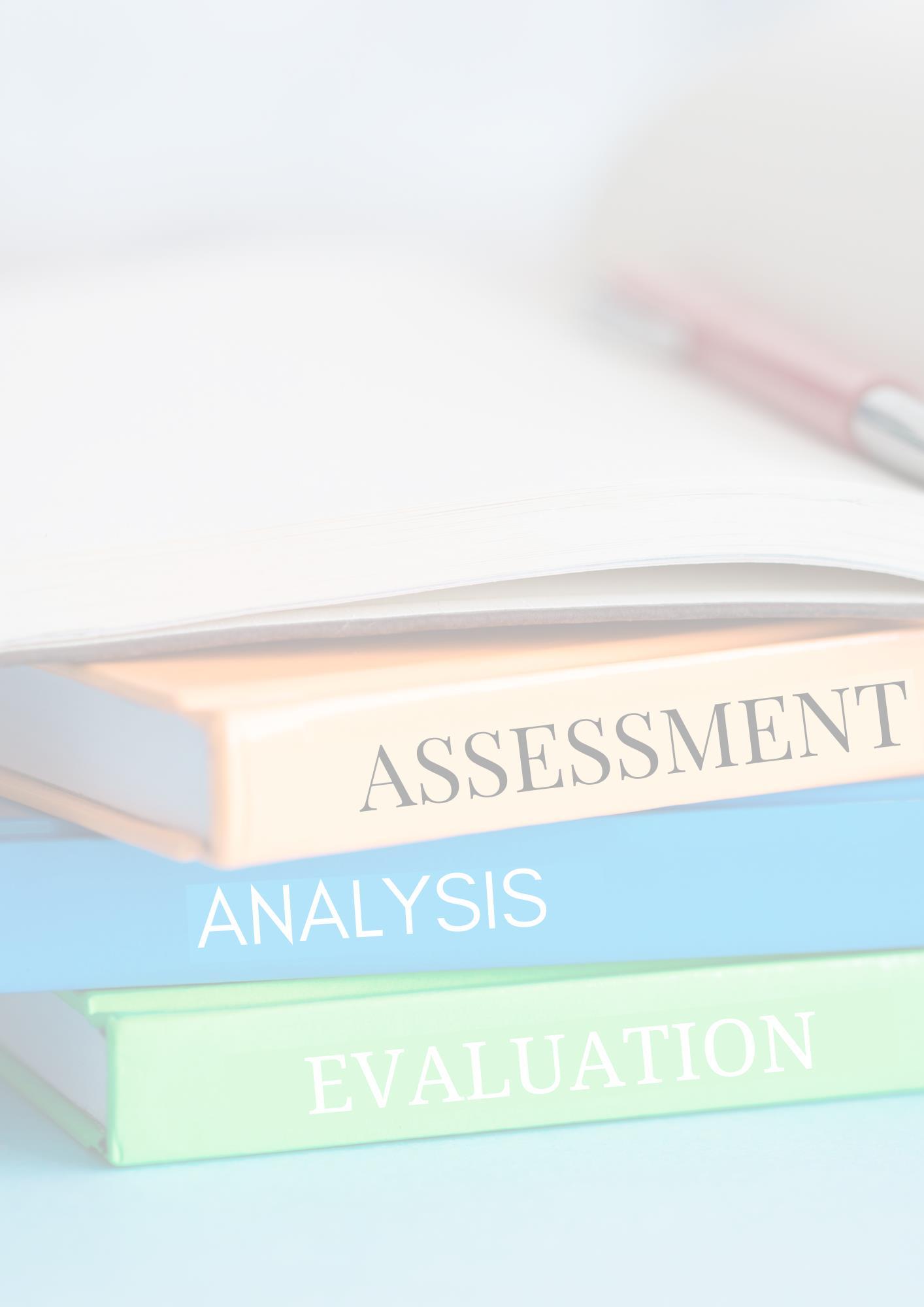

Entrepreneurial and Intrapreneurial Competences AssessmentAlliance
Systematic Literature Review (SLR) of Existing Tools for Entrepreneurial Assessment and Inventory of Tools
Deliverable 2.2 (WP2)
Dissemination paper
Version 2.0
Last update: March 2022
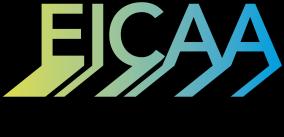
This publication is an internal publication belonging to Work Package 2 of the project Entrepreneurial and Intrapreneurial Competences Assessment Alliance (EICAA).
Manuscript completed in May 2021, reviewed in December 2021, March 2022.
Authors: Marta Carceller (TecnoCampus), Ester Bernadó (TecnoCampus)
Contact information: mailto:ebernado@tecnocampus.cat



The EICAA consortiums consists of the following core partners:


ANTWERP MANAGEMENTSCHOOL

ADSATA EVISTA

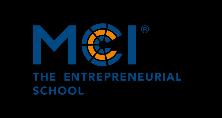
MANAGEMENT CENTER INNSBRUCK

TECNOCAMPUS

PROMEDIA KOMMUNIKATION UNIVATIONS

UNIVERSITY OF SZEGED

UNIVERSITY OF HOHENHEIM




Licence Terms

This work is licensed under a Creative Commons License Attribution-NonCommercialShareAlike 4.0 international License (CC BY-NC-SA 4.0)
Under the licence, you are free to:


SHARE – copy and redistribute the materials in any medium or format
ADAPT – remix, transform, and build upon the materials
The licensor cannot revoke these freedoms as long as you follow the license terms:


Attribution – You must give appropriate credit, provide a link to the license, and indicate if changes were made. You may do so in any reasonable manner, but not in any way that suggests the licensor endorses you or your use.
NonCommercial – You may not use the material for commercial purposes.

ShareAlike – If you remix, transform, or build upon the material, you must distribute your contribution under the same license as original.
No additional restrictions – You may not apply legal terms or technological measures that legally restrict others from doing anything the license permits.






Table of Content 1. Introduction.........................................................................................................1 2. Methodology ........................................................................................................3 2.1. Research questions 3 2.2. Sample ..............................................................................................................3 2.3. Content analysis...............................................................................................3 2.4. Synthesis..........................................................................................................4 3. Entrepreneurial Assessment Tools....................................................................6 3.1. Search ...........................................................................................................6 3.2. Filtered results..............................................................................................8 4. Analysis of the assessment tools 20 4.1 Method.........................................................................................................20 4.2. Content analysis.............................................................................................20 4.2.1. Entrepreneur Scan...................................................................................20 4.2.2. Berkeley Innovation Index.......................................................................24 4.2.3. Entrepreneur Profile Test........................................................................29 4.2.4. Get2 Test for enterprising potential 33 4.2.5. Measurement Tool for Entrepreneurship Education (MTEE) 37 4.2.6. Enterprise Catalyst (E-CAT)....................................................................43 4.2.7. BDC Entrepreneurial Potential Self-Assessment ..................................50 4.2.8. Entrepreneurial Potential and Innovation Competences EPIC.............54 4.3. Insights ...........................................................................................................61 4.3.1. List of tools ..............................................................................................61 4.3.2. Framework foundations of assessment tools 61 4.3.3. Target group.............................................................................................64 4.3.4. Design of the assessment tool ...............................................................64 4.3.5. Complementary aspects of the design...................................................69 5. Conclusions.......................................................................................................73 6. References.......................................................................................................75
1. Introduction

Entrepreneurial education has become part of the vision and mission of many universities across Europe in the last decades. The early call on the need for more entrepreneurs for Europe (European Commission, 2012) and the recent economic crises along with current’s societal and environmental challenges, have raised a deep awareness in higher education institutions (HEIs) to educate individuals able to address and provide solutions to today and future’s challenges. In this context, entrepreneurship education has been appraised to equip students, and thus the next generation of professionals, with the competences to identify the needs of society, generate ideas and turn these into actionable solutions (Taatila, 2010; Nabi et al., 2017; Dickson et al., 2008; Sánchez, 2013).
Despite the amount of research and experience gathered by educational institutions in the last years, there still is a great dispersity in terms of what to teach and how to teach entrepreneurship. Some authors have grouped the teaching approaches in three categories (Nabi et al., 2017; Heinonen & Hytti, 2010): teaching about entrepreneurship, teaching for entrepreneurship, and teaching through entrepreneurship. The first approach focuses on teaching entrepreneurship as an academic discipline and targets students who are already motivated and aim at gaining a greater understanding of the topic, often from a research perspective. The second approach, teaching for entrepreneurship, is aimed at teaching students the knowledge and skills to start up, with the assumption that this will impact positively the students’ entrepreneurship intention. The latter approach is focused on the role of the entrepreneurial process: it is about entrepreneurial and innovative individuals interacting with their environment, thus discovering, evaluating and exploiting opportunities (Shook et al, 2003). “Through” means that entrepreneurship can be learnt through other subjects beyond entrepreneurship courses and programs. Herein, the expected outcomes and impacts are not necessarily the number of startups created, but rather the development of entrepreneurial competences that equip the students for a working life in many potential scenarios and are ready to anticipate and respond to future challenges. Thus, the latter approach takes a broader perspective by focusing on the development of entrepreneurial competences while the students study other courses, often with methodological approaches such as project-based or challenge-based learning. Research findings indicate, though, the risk of inducing some gaps in the competence development set of the students under these programs. A recent study found that ‘unintentional entrepreneurship courses’ easily expose students to entrepreneurial competences such as creativity, learning from experience and financial literacy, while other relevant competences such as opportunity recognition, perseverance and mobilizing resources do not receive similar attention (Stenholm et al., 2021). We hypothesize that this may happen in other approaches as well.
In any case, either if teaching entrepreneurship is made via explicit or implicit methods, a complete characterisation of the entrepreneurial competences, together with proper assessment tools, are required. EntreComp, the Entrepreneurial Competence Framework developed by the European Commission (Bacigalupo et al., 2016a), defines a list of 15 competences grouped in three competence areas: Ideas and Opportunities, Resources, and Into Action. Additionally, the framework provides a list of threads, which detail how each competence is deployed in specific learning outcomes along 4

1
proficiency levels and eight progression levels within these proficiencies. The translation of a competence framework into competence assessment tools serves to identify the developmental needs of a group of students or individuals. There are different scenarios for which assessing entrepreneurial competences of individuals is beneficial. It can be useful at the start of a course or program, to design the best program interventions, as well as at the end of the course, to assess impact of the entrepreneurship education. However, assessments can also be done for entire organisations as this allows them to become knowledge of their own entrepreneurial competence profile.
Higher Education Institutions have been aware of the need of assessing entrepreneurial competences and this has led to the development of a great set of tools, often targeted to a particular institution or program. The design of such tools has often been devised from the research and experience of a given HEI and do not normally belong to wellknown competence frameworks. While EntreComp provides a reference framework for entrepreneurial competences, there are few surveys which rely on this framework (Bacigalupo et al., 2016b), probably due to its complexity and extension.
The aim of this research is to develop an updated and detailed categorization of the most relevant entrepreneurial assessment tools existing in the literature and currently available online. The goal of this review is to provide a list of the most relevant tools, together with a detailed analysis of their components. One of the benefits of this analysis is to provide guidance to researchers, teachers, trainers and coaches on the best tools available to assess entrepreneurship competences. By doing so, we aim at providing clarity on what tools are available, and under which frameworks or theoretical foundations these surveys are built.
This research not only applies to the context of HEIs, but also in any other setting where individuals are asked to provide solutions to today’s challenges, either in governmental agencies, consultancies, start-ups, established companies and organisations of all types. Any organisation that aims to develop the entrepreneurial competences of their staff is potentially interested in assessing the entrepreneurial competences of their employees and managers, to identify individuals’ and teams’ strengths and weaknesses, and building on that, devise training and mentoring programs.
As part of the project EICAA (Entrepreneurial and Intrapreneurial Competences Assessment Alliance), funded by the European Commission under the Erasmus+ program, this document contributes to the achievement of the project's objective, which is to develop a digital platform for the assessment and development of entrepreneurial and intrapreneurial competences. This analysis also serves as a foundation for EICAA’s Competence Monitor, by identifying best practices and potential limitations of the existing tools, and thus helps to design a new assessment tool.

2

2.Methodology
A literature review has been conducted in order to find different entrepreneurial assessment tools available for analysis. The following subsections detail the research questions for this review and how we collected the sample of tools and performed the content analysis and subsequent synthesis.
2.1. Research questions
To conduct the inventory and analysis of existing entrepreneurial assessment tools we were guided by the following research questions:
1. What are the entrepreneurial assessment tools listed in the literature and/or used for relevant educational and business organizations available online?
2. Are the entrepreneurial assessment tools well-founded on a given competence framework?
3. What is the target group of the assessment tool (entrepreneurs/students/employees…)?
4. What are their characteristics in terms of dimensions of the test, number of questions, type of questions, and expected time to complete the survey?
5. What are the complementary features of the assessment tool, in terms of instructions provided to the participant, design of the test, and feedback given?
2.2. Sample
The sample consisted of research papers obtained with a systematic search in databases Web of Science, Scopus, Inform/ProQuest, SAGE and Emerald Insight. The search terms were combinations ofthe following terms appearing as the title of the paper:
• Competence or skill and derivations of these terms.
• Entrepreneur* and intrapreneur*, including terms such as entrepreneurial, entrepreneurship, entrepreneur(s), intrapreneurial, intrapreneurship and intrapreneur(s), among the most common.
• Survey, poll, questionnaire, assessment, scale, instrument, test, and derivations.
2.3. Content analysis
To answer the research questions, we developed a code book which was coded in a spreadsheet file. The content analysis and completion of the code book was performed by a reviewer and was revised by a senior researcher. The code book did not suffer changes along the coding. Table 1 shows the code book.

3
2.4. Synthesis
Once the coding was completed, the synthesis phase consisted in analysing the characteristics of each competence assessment instrument and benchmarking them. The aim was to identify best practices as well as limitations of the existing survey. As a result of this analysis, the current document presents key insights and recommendations that are useful for the design of EICAA’s Competence Monitor.
Code
Description
Source Reference of paper and/or web site if available.
Author Author of the tool: individual, educational institution, business or other organisation who designed and implemented the tool.
Target Target group to whom the survey is designed (e.g., students, entrepreneurs, employees…)
Aim Aim or purpose of the assessment tool (e.g., entrepreneurial competences, personality traits of the entrepreneur, innovation capacity…)
Competence
Framework
Versioning
Time
Dimensions
Number of questions
Type of questions
Instructions
Taxonomy or competence framework of reference in which the assessment tool has relied.
Whether several versions of the test exist, and if so, which one is used for the current analysis.
Expected time needed to complete the survey
Structure of assessment tool in dimensions or subdimensions.
Number of questions or items of the test. Also, whether it is variable or fixed.
Open questions, closed questions, Likert-scales…
Instructions provided to the participant to answer the assessment. They could be related to the aim of the test, the time to complete the survey, motivational messages, etc.
Pre-test Questions asked to the participant, beyond the targeted questions of the survey, such as demographics questions.
Post-test
Same as before, asked upon completion of the survey.
Feedback Feedback provided to the participant after completing the survey.

4
Table 1. Code book used in the literature review
Code Description
Source
Reference of paper and/or web site if available.
Author Author of the tool: individual, educational institution, business or other organisation who designed and implemented the tool.
Target Target group to whom the survey is designed (e.g., students, entrepreneurs, employees…)
Aim Aim or purpose of the assessment tool (e.g., entrepreneurial competences, personality traits of the entrepreneur, innovation capacity…)
Competence Framework
Versioning
Time
Dimensions
Number of questions
Type of questions
Instructions
Taxonomy or competence framework of reference in which the assessment tool has relied.
Whether several versions of the test exist, and if so, which one is used for the current analysis.
Expected time needed to complete the survey
Structure of assessment tool in dimensions or subdimensions.
Number of questions or items of the test. Also, whether it is variable or fixed.
Open questions, closed questions, Likert-scales…
Instructions provided to the participant to answer the assessment. They could be related to the aim of the test, the time to complete the survey, motivational messages, etc.
Pre-test
Post-test
Questions asked to the participant, beyond the targeted questions of the survey, such as demographics questions.
Same as before, asked upon completion of the survey.
Feedback Feedback provided to the participant after completing the survey.

5

3.Entrepreneurial Assessment Tools
3.1. Search
We searched entrepreneurial assessment tools in the literature and in other sources. The search performed in the literature and the search criteria that we used are shown in Table 2. As it can be seen, we searched in relevant data bases and we consistently searched for the key words entrepreneurship and intrapreneurship and derivations, competence and derivations, and survey, different synonyms and derivations. The table details the search statements and the results obtained in each case.
Search Engine Search criteria Results
ProQuest Central ti((survey OR poll OR question*) AND entrepreneur* AND (competenc* OR skill))
Constraint: Articles by experts
Dates: 2000-2022
ProQuest Central ti((survey OR assessment OR scale OR instrument OR questionnaire) AND (entrepreneur*) AND (competenc* OR skill))
Constraints: peer reviewed; english; scientific magazines
5 results.
34 results.
SAGE Journals
Discipline: Social Sciences & Humanities
Emerald Insight
for [[Title survey] OR [Title assessment] OR [Title scale] OR [Title instrument] OR [Title questionnaire]] AND [[Title entrepreneur*] OR [Title intrapreneur*]] AND [[Title competenc*] OR [Title skill]]
(title:"entrepreneur*" OR title:"intrapre*") AND (title:"skill" OR title:"competenc*") AND (title:"survey" OR title:"assessment" OR title:"scale" OR title:"instrument" OR title:"questionnaire")
Science Direct Title: (entrepreneur OR entrepreneurial) AND (skill OR competence OR competencies) AND (survey OR assessment)
Science Direct Title: (entrepreneur OR entrepreneurial) AND (skill OR competence OR competencies) AND (scale OR instrument)
Science Direct Title: (intrapreneur OR intrapreneurial) AND (skill OR competence OR competencies) AND (scale OR instrument)
7 results
3 results
1 result
2 results
0 results

6
Table 2. Systematic search on different data bases of entrepreneurial assessment tools.
Science Direct Title: (intrapreneur OR intrapreneurial) AND (skill OR competence OR competencies) AND (survey OR assessment)
EBSCO Business Complete (entrepreneur* or intrapreneur*) AND (skill or competenc* or abilit*) AND (survey or questionnaire or instrument or scale or assessment or measure*)
Web of Science Entrepreneur* OR intrapreneur* (Title) and skill or competenc* or ability* (Title) and survey or questionnaire or instrument or scale or assessment or measure*
Scopus ( TITLE (entrepreneur* OR intrapreneur*) AND TITLE (skill OR competenc* OR ability*) AND TITLE (survey OR questionnaire OR instrument OR scale OR assessment OR measure*))
0 results
14 results
56 results
59 results
We also searched in other sources to enhance the scope of our search. The aim is to include surveys that were used by other institutions to assess entrepreneurial skills although they were not published in the literature. To achieve that, we searched for European projectsrelated tothe assessment of entrepreneurial competences and in grey literature.
In particular, two projects that had already conducted a literature review were found. The published information of the Erasmus+ projects "Practical Entrepreneurial Assessment Tool for Europe" (EntreAssess) and the “Evaluation of Entrepreneurship Education Programmes in Higher Education Institutions and Centres” (EEEPHEIC), both funded by the European Commission, have also been used as another thread of our search.
On the one hand, the aim of the EntreAssess project, selected inside the Erasmus+ KA2 call from the year 2016, was to develop a progression model for assessment in entrepreneurship education as well as presenting an overview of innovative and adaptable assessment tools.
On the other hand, EEEPHEIC project, funded by the European Commission in 2017, developed a flexibly applicable online tool called EPIC, as well as a categorisation model of entrepreneurship courses and programmes. The EPIC tool measures entrepreneurial competences based on the EntreComp Framework (EU, 2016).
The documentation available in these projects provided a good source of entrepreneurial assessment tools that were used by different institutions (see Table 3).

7
ASTEE Berkley Innovation Index GEM MIND Cette
OctoSkills OICAT GUESS COLLABORATE
ESP Get2Test Durham ETECA SET
LoopMe Go Forth SCALES ATC21S
MTEE Valorise Toi Entreintent SOCCES SKILLOON Enterprise Catalyst Entrepreneurial mindset orientation scale
Entrepreneurial mindset index
*Source:https://heinnovate.eu/sites/default/files/EPIC_Academic%20Literature%20Revi ew.pdf
Further research of our own in grey literature brought some additional assessment tools that were estimated relevant. They are listed in Table 4
Survey
BDC Entrepreneurial potential selfassessment (Bank for Canadian Entrepreneurs)
E-Scan Entrepreneurial Assessment Test
Web site
https://www.bdc.ca/en/articles-tools/entrepreneurtoolkit/business-assessments/self-assessmenttest-your-entrepreneurial-potential
https://entrepreneurscan.com/ Entrepreneur Profile Test
EntreMetric
3.2. Filtered results
https://entrepreneurprofiletest.com/
www.entremetic.com
The final list that resulted out of the different sources is considering 28 tools. Table 5 shows this list. Then, we applied the following exclusion criteria:
• English as a language.
• The surveys needed to be available online at the time of conducting the study, so that the researchers could complete the survey.
• There should be available information about the survey, beyond the list of questions/items.
• Free of charge.
• Standalone assessment survey, not depending on other tools or programs.
After applying the exclusion criteria, eight surveys were finally included in our review. The next section lists the final sample.
.

8
Table 3. List of entrepreneurial assessment tools as collected in the EPIC literature review article.
Table 4. Other entrepreneurial assessment tools found in grey literature.
Tool Description Website Target group Platform Registration Tested?
ASTEE Assessment Tools for Entrepreneurship Education
Developed to assess entrepreneurial skills, knowledge, attitudes, and mindsets of students from primary, secondary and tertiary level of education. The use of these tools before and after the training action were recommended.
Developed under ASTEE project, cofunded by the European Community, the Competitiveness and Innovation Framework Programme (CIP), which lasted from December 2012 until June 2014.
ATC21S Assessment and Teaching of 21st century skills
Sponsored by Cisco Systems Inc., Intel Corporation and Microsoft Corp. Aim: to research and develop new approaches, methods and technologies for measuring the success of 21st-century teaching and learning in classrooms around the world. The project is focused on defining these skills and developing ways to measure them.
Not found.
Link to a report about how it was developed:
https://eng.ffeye.dk/media/789196/a stee-report-rev.pdf
Students from primary, secondary and tertiary level of education.
Not found Not found No (not found)
http://www.atc21s.org/ Students Website. The test has not been found
The test has not been found No
BDC Entrepr
Developed by BDC (Business Development Bank of Canada).
https://www.bdc.ca/en/ articlesStudents, employees, Website No Yes

9
Table 5. List of tools resulting from the search, with the exclusion criteria analysed.
Tool Description
eneurial potentia
l selfassess ment*
It measures the aptitude, motivations and drive to run one’s business.
Website Target group Platform Registration Tested?
tools/entrepreneurtoolkit/businessassessments/selfassessment-test-yourentrepreneurialpotential
employers, entrepreneurs Berkley Innovati on
Index*
A quantitative approach to measure, track and forecast innovation capability within individuals and organisations. Based on BMoE framework, which identifies ten behavioural patterns of successful entrepreneurs.
COLLA
BORAT
E -
Enterpri se Catalyst *
Originally developed by Dr. David Johnson, it has been used in different institutions across the UK. The test measures the aspirations, attitudes and activities of individuals in relation to a number of entrepreneurial factors.
Entreint ent -
Entrem etric
Measuring Entrepreneurial Mindset
EntreMetric's EQA is an online assessment that provides quantitative information about how well the assessment taker's entrepreneurial mindset aligns with successful
https://innovationindex.anvil.app/ Unspecified Website/a pp No Yes
Not found Not found Not found Not found No
https://www.enterprise catalyst.co.uk/ All kind of profiles: students, employees, entrepreneurs...
Website Yes. It's free Yes
Not found Not found Not found Not found No
https://entremetric.com / Individuals, SBA Small Business Development Centers (SBDCs), lending agencies,
Web Registration needed. Not accessed

10
Tool Description Website Target group Platform Registration Tested?
entrepreneurs in five statistically derived areas. The EQA report contains statistical and written feedback about the assessment taker's entrepreneurial mindset. The assessment is a useful tool to assess people and programs interested in entrepreneurial mindset such as students and academic programs, companies wanting to understand their intrapreneurship culture, startups, incubators and accelerators, small business lending, and leadership programs.
Entrepr eneurial mindset index (EMI)TM
Developed by The Network for Teaching Entrepreneurship (NFTE)
Aim: to measure mastery in eight core domains that have been identified as critical to entrepreneurial thinking. It is an instrument to measure entrepreneurial mindset, and the eight domains are captured with Likert items and Situational Judgement Tests.
https://www.nfte.com/e ntrepreneurialmindset/
More info: http://accelerationgrou p.net/wpcontent/uploads/2019/ 01/MeasuringEntrepreneurialMindset-in-YouthNovember-2018.pdf
incubators, educational programs and universities.
Students Website. The test has not been found
The test has not been found No
Entrepr eneurial mindset orientat
-
Not found Not found Not found Not found No

11
Tool Description
Website
Target group Platform Registration Tested? ion scale
Entrepreneur Profile
Test*
EPIC Tool*
Developed by Stefan Lindstrom, consultant, and Hans Olle Frummerin, psychologist. Test that categorises an individual in one of six entrepreneurial profiles or archetypes that the tool has identified.
https://entrepreneurpro filetest.com/ Entrepreneurs, students, employees, employers, talent recruiters...
Website Yes, it's free Yes
E-Scan
Entrepr eneurial Assess ment
Text*
Tool developer under an EU-funded project. It measures entrepreneurial competences on students before and after a course. It is based on EntreComp framework.
Tool developed by a consultant company, targeting entrepreneurs and other individuals. The survey is built upon a competence framework developed by the company named “Entrepreneur Competence Model”. The survey tests motivation, personal characteristics, qualities or abilities and knowledge and experience.
ESP Entrepreneurial Skills Pass
Self-assessment tool of entrepreneurial competences. Developed under the ESP project, funded with support from the European Commission, under the Leonardo da Vinci Programme.
https://heinnovate.eu/e n/user/login?destinatio n=epic/dashboard
Teachers and Higher Education Institutions
Website Yes Yes
https://entrepreneursc an.com/ Unspecified Website Yes, it's free Yes
http://www.entreprene urialskillspass.eu/ Students aged 15-19. The final exam can be taken at the end of the learning experience.
Web Registration is needed and the user receives a verification code in order to apply as candidate or trainer.
The test should be taken once the participant has had a real entrepreneur

12
Tool Description
The aim was to develop a certificate for students aged between 15 and 19 years old that had a real entrepreneurship experience after passing an examination. In the project a full-year in-school programme experience was implemented together with an assessment of the entrepreneurial competences and an examination.
ETECA -
GEM Global Entrepreneurship Monitor
Project started in 1999 as a joint research between Babson College (USA) and London Business School (UK).
They carry out survey-based research on entrepreneurship and entrepreneurship ecosystems around the world.
They collect data on entrepreneurship directly from individual entrepreneurs.
Aggregated tests. All GEM data collection is centrally coordinated. GEM data experts work closely with National Teams and survey vendors
Website
Target group Platform Registration Tested?
ship experience. The test cannot be taken without the program experience.
Not found Not found Not found Not found No
https://www.gemconso rtium.org/ Data is collected from individual entrepreneurs.
GEM data and tools can be used by academics, policymakers, entrepreneurs, sponsors and organizations.
Internal GEM staff only
Not possible to register and take the test by your own.
Not possible to register and take the test by your own.

13
*
Tool Description
Website Target group Platform Registration Tested? to guarantee the quality of the data. All surveys are subject to a range of checks before data collection begins. The resulting data is scrutinised repeatedly before release. These processes, developed over many years, ensure that GEM data is of the very highest quality.
The data collection engine powering GEM research is composed of two complementary tools - the Adult Population Survey (APS) and the National Expert Survey (NES).
Get2Te st Durham
Developed by Durham University Business School, the test measures the entrepreneurial characteristics most related to entrepreneurial behaviour: motivation, creative tendency, calculated risk-taking, and internal locus of control.
GUESS Global University Entrepreneurial Spirit Students’ Survey
Research project about students entrepreneurship. Every 2–3 years, a global data collection effort takes place. For every participating country, there is one responsible country team which coordinates data collection in that country.
http://www.get2test.net / Unspecified Website No Yes
https://www.guesssurv ey.org/ Country teams or as university partners
Website For the next GUESSS edition in 2023, detailed information about how to participate will be available soon.

No
14
Tool Description
Go Forth Canadian online training platform for entrepreneurs that includes series of short instructional videos that costs 16,25 dollars per month.
Website Target group Platform Registration Tested?
https://www.goforthinst itute.com/training Entrepreneurs Website/a pp Yes. The test is linked to a training, and there is the possibility to pay for this training.
No
LoopMe Formative assessment tool that allows teachers to design an action-based learning experience by breaking it down into manageable tasks for students, creating one-to-one dialogs between teachers and learners.
https://www.loopme.io/ Users in the fields of education, management and research.
Cloudbased service used on the web, tablet or smartpho ne
There are 4 types of fares: Free trial for 30 days, Basic for 4€/month, Standard for 8€/month, and Plus for 12€/month
No (it is not a predesigned test, but a tool for teachers, managers or researchers who can freely determine the questions or tasks to be performed by the group of individuals. Examples can be found but none of them analyse

15
Tool Description
MIND Cette - MIND Cette. Dr. Shaver, researcher and professor at the College of Charleston (USA), developed a website and a test for entrepreneurs to allow them to know where they stand on dimensions that are related to entrepreneurial success.
MTEE* Measurement Tool for Entrepreneurial Education
Developed by LUT University, measures the impact of
Website Target group Platform Registration Tested? entrepreneur ial competence s through a questionnair e. They are examples of tasks that a student/work er/individual can perform on their own under the supervision of a teacher or leader).
https://www.mindcette. com/ Companies Website An email has to be sent to test the company’s entrepreneurial capacity.
No
https://eumtee.lut.fi/ Teachers in entrepreneurial training
Website Yes, it is free. Yes

16
Tool Description Website Target group Platform Registration Tested?
entrepreneurship education at the teachers’ level.
OctoSki
lls
OctoDa
sh
Application tools to assess students’ self-efficacy and entrepreneurial attitudes and intentions.
Developed by the Danish Foundation for Entrepreneurship, based on the EU-funded ASTEE project.
OICAT Towards an Opportunity Identification Competence
Assessment Test.
A study led by researchers of different European universities elaborated a test of a performance assessment to investigate the “Opportunity Identification Competence” (OIC) of students in higher education. This instrument had 2 tasks:
• Task 1 related to business opportunity idea generation and based on the instrument of Corbett (2007). Students were asked to generate as much ideas as possible within 10 minutes on sustainable development after reading the case.
• Task 2 related to evaluation of opportunities for their potential to
http://www.octoskills.c om Teachers (OctoSkills) and department leaders of education institutions (OctoDash)
The instrument has not been found although the research papers are published:
https://www.researchg ate.net/publication/315
664337_Development _and_application_of_t he_opportunity_identifi cation_competence_a ssessment_test_OICA T_in_higher_education
App (not found) App (not found) No (not found)
Students of higher education. Not found Not found Not found

17
Tool Description
become a successful start-up. Ten arguments were presented: five of them in line with the profile of a novice entrepreneur and 5 of an experienced entrepreneur. Students were asked to select 5 arguments they thought the most important when determining the potential of business opportunities in five minutes.
Website Target group Platform Registration Tested?
SCALE SNot found Not found Not found Not found No
SETNot found Not found Not found Not found No
SKILLO ON Personal trainer platform for students that includes assessment tools, activities and a personal portfolio system for students.
SOCCE S Project coordinated by Coventry University (UK)
Consists of developing a framework and a methodology for assessment of
https://skilloon.com/ Teachers and students Website Yes. You can also ask for a demo via email.
No
Not found.
Handbook:
https://www.academia. edu/36257119/SOCC ES_HANDBOOK_ASS ESSMENT_OF_TRAN SVERSAL_COMPETE NCES_FOCUS_ON_E
Not found Not found Not found No

18
NTREPRENEURSHIP _SENSE_OF_INITIATI
Tool Description
two competences important for working life:
• Sense of Initiative and Entrepreneurship
• Social competences. The project started in February 2015 and finished in 2017.
Valorise Toi
Developed by the National Work Team of Scouts et Guides de France with the aim of helping to enhance the value of the skills gained through volunteering. It consists in gaining recognition in the university and professional fields for the richness, diversity and seriousness of the skills acquired and implemented around the role of Responsible in Scouting.
*Tools highlighted in green have been tested and analysed.
Website
VE_AND_SOCIAL_SK ILLS
Target group Platform Registration Tested?
Not found.
Manual: http://euroscoutinfo.co m/wpcontent/uploads/2012/ 02/empower_yourself_ final_version.pdf
Not found Not found Not found No

19

4.Analysis of the assessment tools
4.1 Method
The methodology used to conduct the analysis consisted of carrying out and analysing the questionnaire for each of the tools, taking into account the elements contained in the codebook detailed in Table 1. After the individual analysis of the tool, we are able to provide a joint analysis for each of the codes and extract meaningful insights on the design, structure and contents of these tools
4.2. Content analysis
4.2.1. Entrepreneur Scan
Survey Entrepreneur Scan - Entrepreneurial Personality test
Website
Who is behind the test
https://entrepreneurscan.com/blog/skills-abilities-knowledgecompetencies/
Entrepreneur Scan (company)
TOOLS FOR COACHES AND TEACHERS TO ASSESS AND COACH THEIR CLIENTS’ MINDSET AND GROW THEIR BUSINESSES.
Target Not specified (any entrepreneur or student).
Professional context.
Aim Test entrepreneurial mindsets to provide coaching afterwards.
Taxonomy or competence framework
For the entrepreneurial personality, a new competency model was created, named Entrepreneur Competence Model (ECM). It arose from scientific research into entrepreneurship as professional competence. It contains four essential elements, which, together, they form a competency:
• Motivation; why do you want to be an entrepreneur?
• Personal characteristics; who are you really as an entrepreneur?
• Qualities or abilities; what can you do well as a business owner?
• Knowledge & experience; do you know what others know to use in your business?
Personal Characteristics

20
Survey Entrepreneur Scan - Entrepreneurial Personality test
The characteristics are a large and essential part of the results of the entrepreneurial mindset tool E-Scan. These traits are what make someone entrepreneurial.
• Achievement
• Autonomy
• Power
• Social orientation
• Self-belief
• Perseverance
• Risk-taking
• Pioneer thinking style
• Salesperson thinking style
• Manager thinking style
• Specialist thinking style
Qualities:
• Leadership competencies in jointly achieving organizational goals
• Motivating, interpersonal skills, and communication skills for employee development
• Planning and management of employee performance
• Financial management
• Market orientation as a specific skill of commercially interpreting client’s observable behavior
• Creativity and innovation
• Flexibility
Knowledge and experience:
Marketing & Sales and strategy
• Organization, (besides technical skill) technical knowledge
• People (human resource) and type of job function needed
• Finance and pricing
• Market demand and supply
Several versions of the test
Time
Number of questions (items)
No
16’ estimated (in some cases, 10’)
109
Instructions Tips given at the beginning of the test (e.g., Don’t think too long, There is no right or wrong answer). Estimated time provided.
Prequestions
How entrepreneurial are you? (scale 0-100)

21
Survey Entrepreneur Scan - Entrepreneurial Personality test
Postquestions -
Dimensions or structure of the test
Format of questions
Examples of questions
Not clear structure. They probably follow the taxonomy. Items are not sorted.
• Self-assessment (Likert scale): 93
• Self-assessment (sort the answers): 16
• Motivational sentences while answering the test. E.g., “Perseverance is important in entrepreneurship. Keep up”.
Likert scale:
• “I rarely set goals for myself.”
• “I am afraid to fail.”
• “I like to invent new products or services.”
• “I often talk with people.”
• “I want to decide everything myself, no one else may make decisions for me.”
Sorted options:
Sort the following options. Which option is most applicable to you? 1(most)-4(least):
1 Someone who enjoys experimenting.
2 Someone who works structured.
3 Someone who gladly assists others.
4 Someone who is always right.
Feedback or report given
Yes. Calculation of the entrepreneurial index after the test and comparison with the estimated entrepreneurial index. After that, explanation of how entrepreneurship can be developed:

22

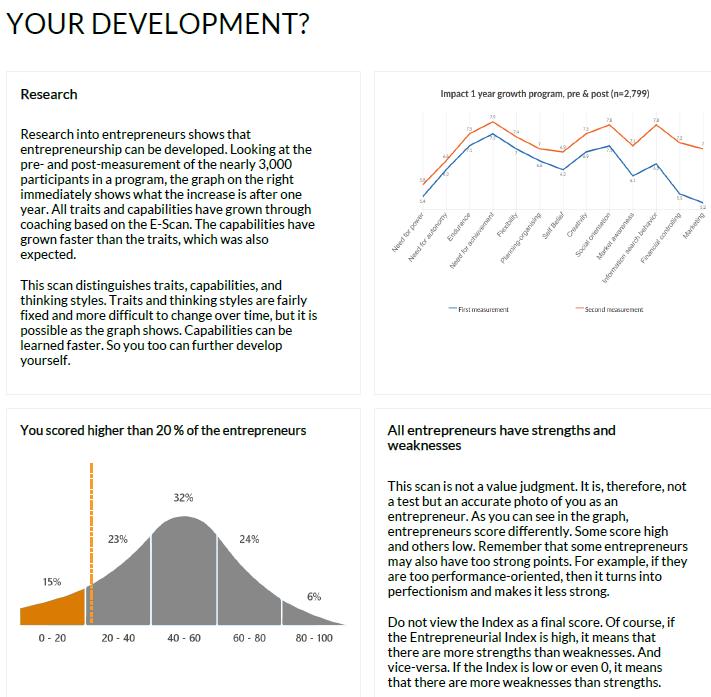

23 Survey Entrepreneur Scan - Entrepreneurial Personality test
Survey Entrepreneur Scan - Entrepreneurial Personality test

Validated instruments or results obtained
Other The website contains additional information:
Learning styles of entrepreneurs
Different learning styles are of particular interest.
• Accommodator; learns by doing, but analyzing information is a problem.
• Diverger; learns by observing and generating ideas but finds it difficult to be practical.
• Converger; learns by putting it into practice and solving specific problems but tend to close their eyes for other ideas and suggestions.
• Assimilator; learns by carefully analyzing problems and information but fails when immediate action and decisions are needed.
Internal Notes
Interesting definitions of the personal characteristics.
4.2.2. Berkeley Innovation Index
Survey BII (Berkeley Innovation Index)
Website https://innovation-index.anvil.app/
Who is behind the test
UC Berkeley’s Sutardja Center for Entrepreneurship and Technology (SCET) in cooperation with industry professionals.
BMoE framework: has identified ten behavioral patterns of successful entrepreneurs and, by using inductive and game-based teaching, the mindset behind the behaviors can be explored.

24
Survey BII (Berkeley Innovation Index)
The ten behaviors are; Pay It Forward, Story Telling, Friend or Foe, Seek Fairness, Plan to Fail, Diversify, Role Model, Believe, Good Enough, and Collaboration.
Target • Students (STEM students to foster entrepreneurial mindset).
• Educational/ Organisations
Aim The Berkeley Innovation Index: A Quantitative Approach to Measure, Track and Forecast Innovation Capability Within Individuals and Organizations.
Measures individual’s innovative mindset level, by relating it to traits linked to individual innovation capability.
Taxonomy or competenc e framework
The Berkeley Innovation index is a psychometrics tool that quantifies and measures an individual's or organization's overall innovation capabilities.
The index assesses overall innovation capability as well as six subtraits. The subtraits constitute a subset of the ten mindsets in the Berkeley Method of Entrepreneurship, hence they are linked to innovation performance.


25
Survey BII (Berkeley Innovation Index)
The BII deconstructs six of the ten traits identified with an entrepreneurial mindset in the Berkeley Method of Entrepreneurship. It is these six personality traits that form the basis of the BII. The approach is also intended to cover layers of innovation that range from the following fields:
1. Strategy and Leadership,
2. Innovation Culture from an Organization’s Viewpoint,
3. Organizational Operations and Measures across functions,
4. Mindset: The Innovation DNA of the People,
5. Tactical measures.
Several versions of the test
• BII test for individuals
• An extension is designed for organisations.
Time 10 minutes
Number of questions (items)
Instructions
31
• Indicate how you perceive yourself
• There are no right or wrong answers.
• Simply answer honestly.
Prequestions -
Postquestions -
Dimensions or structure of the test
Each question belongs to a subcategory, and each category is related to a trait that has been linked to innovation capability.
The BII algorithm, which calculates the scores for the traits, has been developed utilizing a Higher-Order Item Response Theory approach.
This makes the inferred index scores statistically relevant according to contemporary algorithmic theory and survey design.
Format of questions
The test questions are not a measure of knowledge learned, but instead they form an instrument that measures what students believe about themselves at a psychological level.
Two parts of the test:
• [1-26] Self-assessment (Likert scale strongly disagree-strongly agree)
• [27-31] Situational judgement

26
Survey BII (Berkeley Innovation Index)
Examples of questions
Part 1 (beliefs):
• “I trust other people”
• “Failure often leads to positive outcomes in the long run”
• “When I see a better way of doing something, I can influence the organisation where I work or the people around me who adopt that new approach”
• “I can allocate resources adequately.”
Part 2 (seem like behaviours or situational based questions about how you behave):
• “How comfortable are you in making decisions under uncertainty in your professional life?” Choose: “Uncomfortable. “Comfortable with 75% of information”. “ Comfortable with 30%·. “10%”.
• “What do you do when you disagree with others?”
• “I feel I have already been successful in entrepreneurship and innovation”
Feedback or report given
Yes (see below)
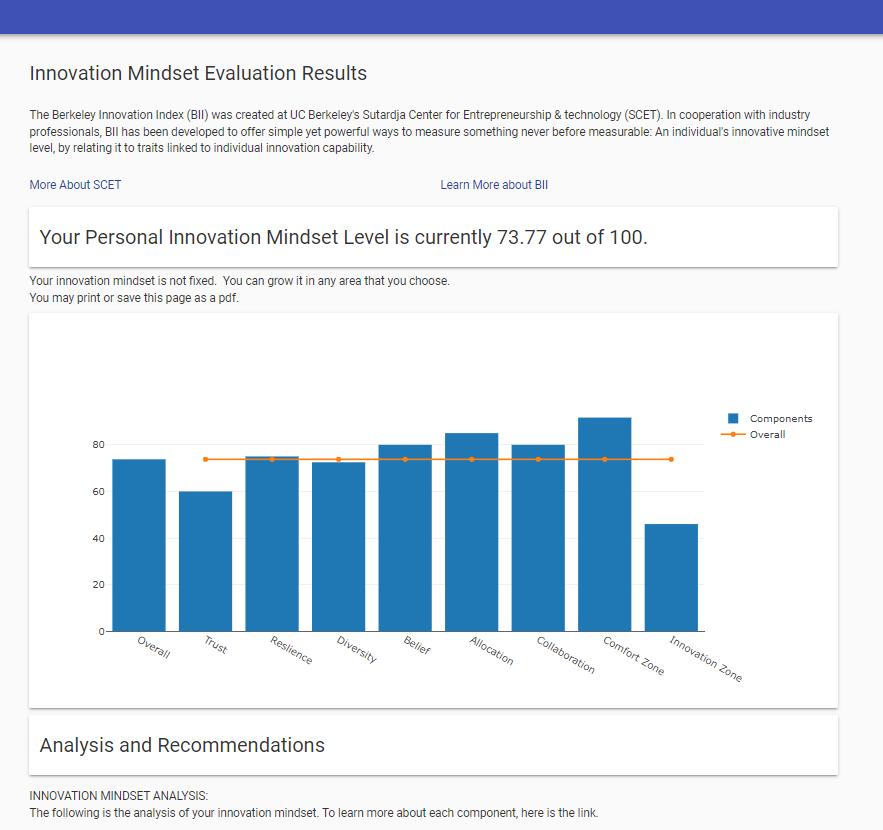

27

Validated instrument or results obtained
Other
Internal Notes
Over 6.000 individuals have already taken the BII surveys
A second psychometrics instrument has been designed and implemented in the Berkeley Innovation Index suite. This tool focuses on the culture of the workgroup as measured by the perceptions of the individuals in the workgroup on the organization and team they are part of.
Areas of measurement that are included in the Workgroup measurement:
1. Where ideas originate
2. Transparency in decision making
3. Organizational comfort with ambiguity and learning
4. Responses to organizational failures
5. Cultural understanding about operating measures such as product / service quality, customer happiness, cost, and market share.
6. Culture of execution
The results of these questions are then grouped to form a score and measure for the innovation culture (questions 1-3) and operational focus (questions 4-6).
See the link.

28
Survey BII (Berkeley Innovation Index)
4.2.3. Entrepreneur Profile Test
Survey EPT Entrepreneur Profile Test
Website https://entrepreneurprofiletest.com/
Who is behind the test
Stefan Lindstrom Entreprenologist and MBA. Executive coach & management consultant. Creator of the EPT – world’s first Entrepreneur Profile Test, and EPT mark II – 2017 including Intrapreneurship and EPT mark III – 2020 in English.
Hans Olle Frummerin Licensed psychologist and Master of Science. Member of the Swedish Psychological Association. Former management consultant. 2010 Creator of the EPT © – world’s first Entrepreneur Profile Test.
Target
Not specified (anyone, entrepreneur or student).

Aim
Taxonomy or competence framework
This test attempts to measure your entrepreneurial tendencies. Not necessarily targeted at entrepreneurs.
EPT also measures the response congruence and in %. Not all tests that are based on self-estimates.
Stefan Lindstrom:
“
Entrepreneurs have different characteristics that help them succeed in their tasks. Based on international research that identified five profiles. Starter, serial, innovator, professional, lifestyle – entrepreneurs.
After my time in 2005 at Boston University – Entrepreneurial Institute, and around the Boston ecosystem, it was observations I made there that was the starting point in my research within Entreprenology (very latest available here Stefan Lindstrom (researchgate.net)
Later in the years of around 2007, I came up with my first thoughts, and later on, the first embryo that there could be a sixth profile. The Workstyle.
It is this research that led to the world’s first Entrepreneur Profile Test that was launched in 2010.
Entrepreneur Profile Test – EPT, gives a picture of which of the six entrepreneurial archetypes you are closest and or closest to. This test attempts to measure your entrepreneurial tendencies. Whether you actually become an entrepreneur or not is up to you.”

29
Survey EPT Entrepreneur Profile Test
Several versions of the test
Time
Number of questions (items)
Instructions
No
5’ estimated
22 questions + 3 questions to get information of your location, your age and your gender:
While your answers (free of charge) are being processed, we would like to ask you to contribute to our independent research by taking 15 seconds to answer 3 simple questions.
Tips given at the beginning of the test (e.g., Initially, you need to determine your focus, that is to first decide which mental focus (mindset) you relate to in your responses. Free-time focus or Job focus.
• “This is depending on what you want to get out of your EPT. E.g., to make a career change, or to find out what you really want to do, most likely suitable for, or your potential and development opportunities. Within business development like teambuilding or recruitment, Job focus is probably relevant and might be preferred. Feel free to contact us or consult your accredited EPT coach.
• Try to keep that chosen focus in your approach to your answers throughout the whole test, for the most adequate results, and thus for you.
• Also for your most congruent answers and suited for the purpose, do the entire test in one sweep without interruption. And of course, do the test without being disturbed.”
Prequestions No
Postquestions
Dimensions or structure of the test
Format of questions
Examples of questions
3 questions to know some information about you (location, age and gender)
Not clear structure. They probably follow the taxonomy. Items are not sorted.
• Self-assessment (sorted options): 22
Sorted options: I find it most easy:
• Being sensible
• Thinking in several steps
• To laugh as well as cry
• Being intuitive
Which of the following words describes you the best?
• Logical

30
Survey EPT Entrepreneur Profile Test
• Factfinder
• Faith
• Belief-oriented
Feedback or report given
Yes. Information on which type of entrepreneur you are and what this means. It is possible to download the results in a pdf. At the end professional services to get the most out of your results are offered by contacting them by email for more information. Possibility to donate to support their research.
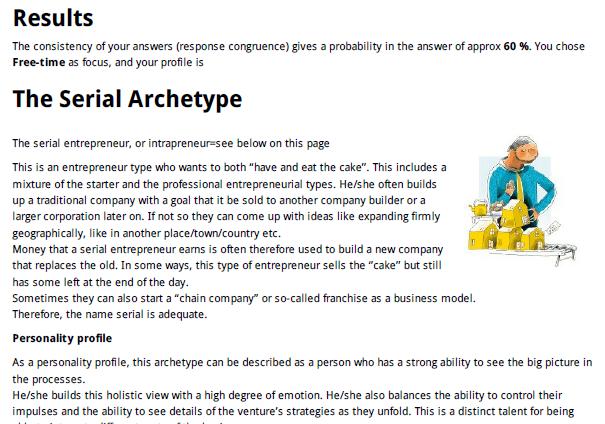

31
Validated instruments or results obtained
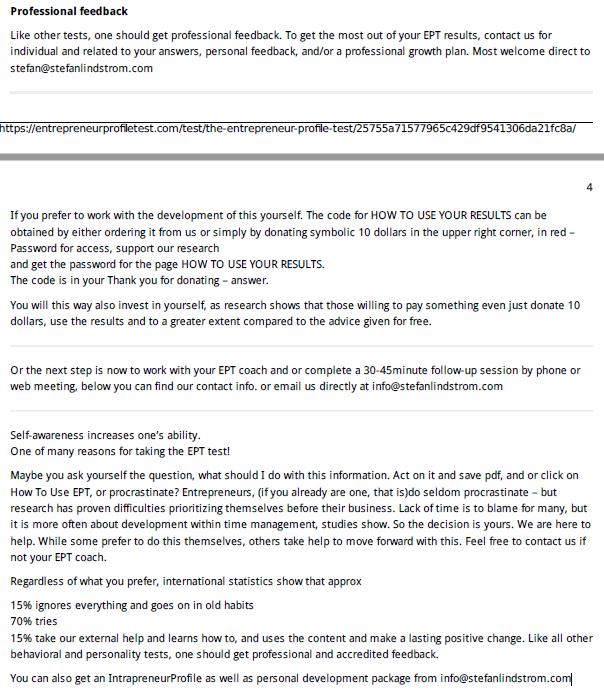
“EPT has proved to have surprisingly high face validity as we have experienced test runs of up to about 5.000 tests performed in Sweden alone. And in the year 2020 over 24.500 tests in Sweden, before we in March launch it in English, and has passed 26.000 in November 2020, and 27.000 in 2021-09-23.”
More information about validation and reliability: https://entrepreneurprofiletest.com/validation-reliability/ Other An Intrapreneur Profile as well as personal development package is offered contacting info@stefanlindstrom.com
Internal Notes -

32
Survey EPT Entrepreneur Profile Test
4.2.4. Get2 Test for enterprising potential
Survey GET2 Test for enterprising potential
Website
Who is behind the test
http://www.get2test.net/
The General measure of Enterprising Tendency (GET) test was developed in 1987-1988 by Dr Sally Caird and Mr Cliff Johnson at Durham University Business School with funding from the University Grants Council whose functions have now been taken over by the Higher Education Funding Council for England.
The research followed a literature review to identify key psychological characteristics of entrepreneurs which could be applicable to other enterprising people. Psychological tests were reviewed and a bank of entrepreneurial descriptive statements was assembled from the literature on entrepreneurs, the psychological tests of key entrepreneurial characteristics and pilot testing with entrepreneurs.
Target “The test is not definitive and it should only be used as an educational aid for thinking about enterprise. You could discuss your responses with a supportive group of students, teacher or friends”
Aim “This test attempts to give you an idea of your enterprising potential”
Taxonomy or competenc e framework
The original GET test was developed as a paper-based research tool with little interpretation for application in classroom face-to-face assessment. The GET test was later adapted for use by Training Enterprise Companies (TEC) in the form of a knowledge-based system to contribute to training business owner-managers. Over the past 30 years there has been considerable worldwide interest in the General measure of Enterprising Tendency (GET test) which has applications in education, research, development and training in higher education, further education and training and school contexts. Due to this interest and the volume of requests for the test, I created this website which is freely available to people who wish to test their enterprising tendency, or for educational and research purposes.
The basic premise of the test is that the enterprising person shares entrepreneurial characteristics. The psychological literature has different views on entrepreneurial characteristics and which ones are important. The approach we took involved the identification of the key characteristics of entrepreneurial people associated with entrepreneurial behaviour, and entrepreneurship itself. The key entrepreneurial characteristics identified were: strong motivation, characterised by a high need for achievement and for autonomy; creative tendency; calculated risk-taking; and an internal locus of control (belief you have control over own destiny and make your own ‘luck’). People set up an enterprise because they are highly motivated (to achieve something themselves) by a good idea and will manage

33
Survey GET2 Test for enterprising potential risks, information and uncertainties because they believe they can set up the enterprise successfully.
The test provides an indicative not definitive measure of enterprising potential, however, and would benefit from further development and testing.
Several versions of the test
No
Time 10’ estimated
Number of questions (items)
54 questions
Instructions Tips given at the beginning of the test:
“The test should be used as an educational aid for thinking about enterprise. Decide if you tend to agree or disagree with the statements. There are no right or wrong answers in this test. It should take you about ten minutes to complete and the report produced will give you an idea of your enterprising potential. For each statement click the answer which best expresses your views. Answer all the questions quickly and honestly since this gives the best picture of yourself as you are now. Note, the test uses cookies.”
Prequestions No
Postquestions No
Dimensions or structure of the test
Format of questions
Examples of questions
Not clear structure. They probably follow the taxonomy. Items are not sorted.
• Self-assessment (participants respond to the questions by indicating whether they tend to agree or tend to disagree, there are only these 2 options): 54
I like a lot of guidance to be really clear about what to do in work.
• Tend to agree
• Tend to disagree
People’s failures are rarely the result of their poor judgement.
• Tend to agree
• Tend to disagree
I prefer to be quite good at several things rather than very good at one thing.

34
Survey GET2 Test for enterprising potential
• Tend to agree
• Tend to disagree
Feedback or report given
Yes. A general score on how enterprising you are and what this means is given. Then it is suggested that you attend free courses in case you have more ambitions:

Finally and analysis of your need for achievement, need for autonomy, creativity tendency, calculated risk-taking and locus of control is done, and a test result summary in a chart:



35
Survey GET2 Test for enterprising potential

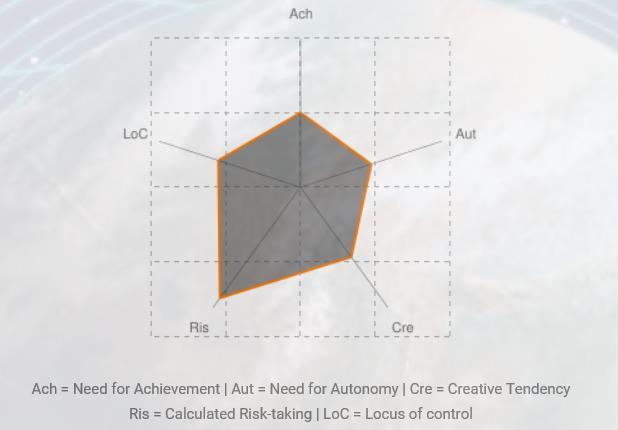
Validated instruments or results obtained
The website hosts some 1,000 users a month who used the GET2 test online. Some of the institutions that used the test can be found in the website http://www.get2test.net/index.html#beingEnterprising
“Construct validity and reliability was established by testing the measure on occupational groups finding that entrepreneurs were significantly more enterprising than teachers, nurses, civil servants and clerical workers and lecturers and trainers, using t-tests for statistical analysis (Caird, 1991 a&b)*. A more complex picture of the differences between occupational groups emerged when specific enterprising characteristics were examined. Entrepreneurs scored significantly higher than lecturers and trainers on the following enterprising characteristics: need for achievement and internal locus of control, but not on the characteristics: need for autonomy, creative tendency and calculated risk taking. Entrepreneurs scored significantly higher than teachers, nurses, and civil servants on the following enterprising characteristics: need for achievement, need for autonomy, internal locus of control, calculated risk taking but not creative tendency. Entrepreneurs scored significantly higher than clerical workers on all enterprising characteristics.” (Caird, 2022).
The results show that entrepreneurs “do not have the monopoly on enterprising characteristics, but are generally more enterprising than the other occupational groups in the study.” (Caird, 2022).
*Reference included in the fragment of text, copied from the web site.

36
Survey GET2 Test for enterprising potential
Other
Internal Notes
The GET2 test is being used by Oxford Innovation Ltd. in the ‘IgniteCornwall’ programme to support business start-ups and economic regeneration in the South West of England.
The following journal articles, reports and book chapters are the main references to the GET2 test, providing details of how it was developed and tested. If you have a paper published referencing GET2, do let us know
Free online education courses are suggested:
Several universities, such as the Open University offer free courses online which may help you to build up your business knowledge and skills (see http://openlearn.open.ac.uk).
There are also many MOOCs (Massive Online Open Courses) freely available on the FutureLearn platform (https://www.futurelearn.com) to help you to learn about technology, business and the economy, learn languages and so on. If you have never set up an enterprise before you might consider starting a small project in your community that represents a minimal risk to your time and money, to build up your experience and expertise.
4.2.5. Measurement Tool for Entrepreneurship Education (MTEE)
Survey MTEE - Measurement Tool for Entrepreneurship Education
Website https://eumtee.lut.fi/
Who is behind the test
LUT University (Finland)
Project Manager Elena Ruskovaara, elena.ruskovaara@lut.fi
Target Education institutions: teachers
Aim Evaluate your activity as a teacher in entrepreneurial learning
Taxonomy or competence framework
The construction of the Measurement Tool has been guided by participatory action research, and case study; the collaboration and shared expertise of the users (teachers) and the designers (researchers) have been central to this project.
According to the authors, The Measurement Tool is unique because it is the world’s first entrepreneurship education self-assessment tool developed for teachers.
Dimensions:
• Dependent variables: Entrepreneurship education practices, identified from literature of entrepreneurship education.

37
Survey MTEE - Measurement Tool for Entrepreneurship Education
• Independent variables: Teacher characteristics (gender, work experience, business background, teacher training courses on entrepreneurship).
• School characteristics: basic education/secondary/vocationalsecondary.
See Oikkonen & Pihkala (2014)

38
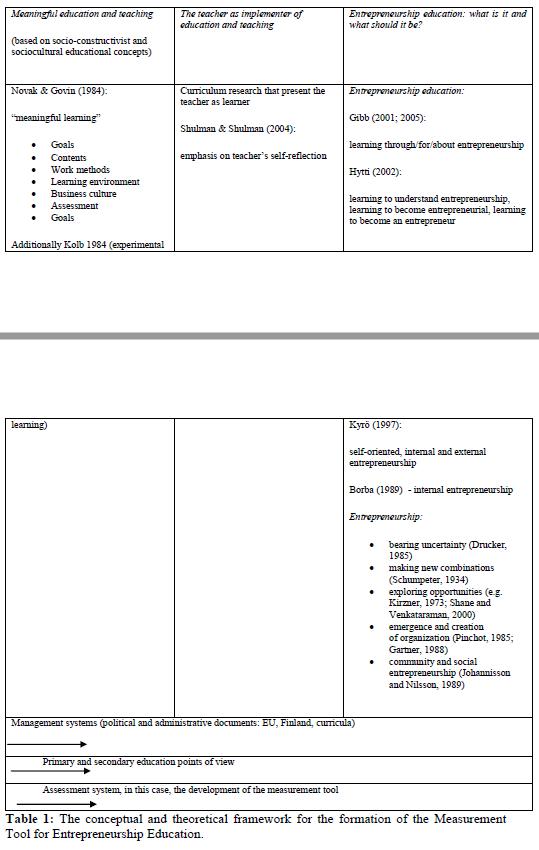
More information on the conceptual framework in this link.

39 Survey MTEE - Measurement
for Entrepreneurship Education
Tool
Survey MTEE - Measurement Tool for Entrepreneurship Education
Several versions of the test
No
Time 7’ estimated
Number of questions (items)
63
Instruction s No. Registration before taking the test is required: “Replying is anonymous, but to be able to follow your development you should create a user profile. Start from 'Register'.”
Prequestions No
Postquestions
Dimensions or structure of the test
Yes, there are 10 questions regarding background information (training, work experience, country, work position, level and size from the school you work for):
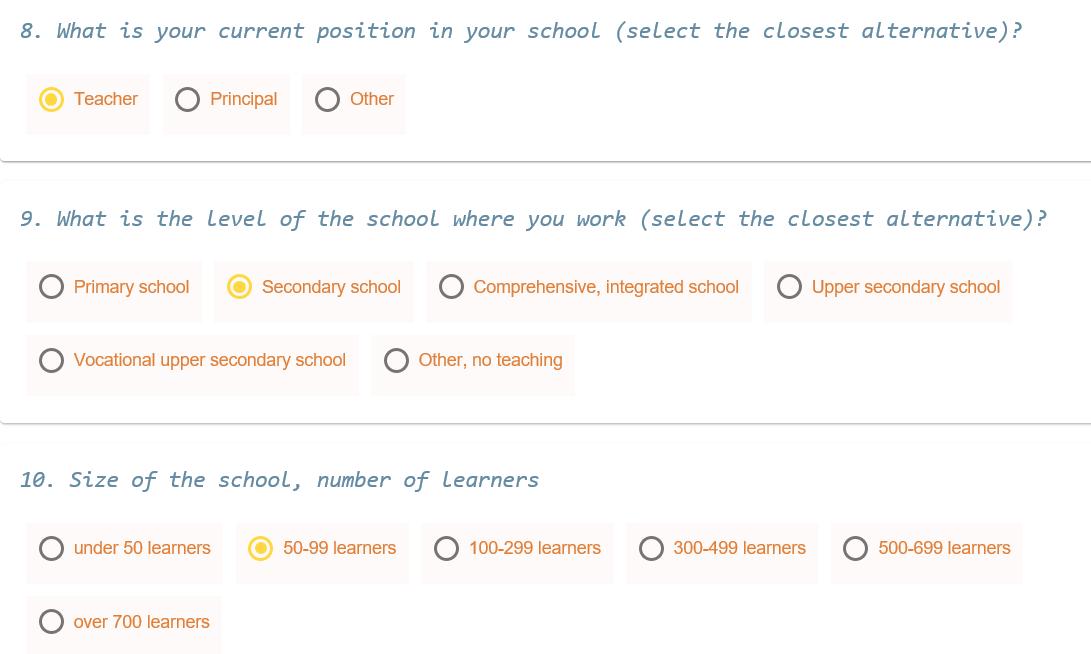
The test is structured as follows:
- Planning for entrepreneurship education (4 questions)
- Entrepreneurship education in my institution (14 questions)
- Methods for Entrepreneurship Education (15 questions)
- Guiding of the learners (10 questions)
- The importance of entrepreneurship (10 questions)
- Background information (10 questions)

40
Survey MTEE - Measurement Tool for Entrepreneurship Education
Format of questions
• Self-assessment (Likert scale from completely disagree to completely agree): 34
• Self-assessment (Numeric line from 0 to 30): 15
• Sort the answers: 8
• Yes/No questions:6
Examples of questions
Yes/No questions:

Likert scale:

Numeric line:

Sorted options (select the answer):
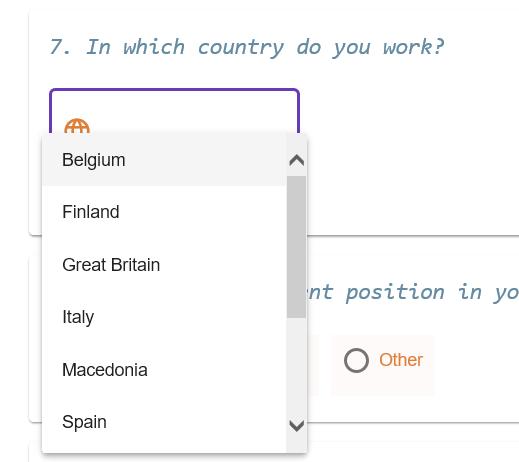

41
Survey MTEE - Measurement Tool for Entrepreneurship Education
Feedback or report given
Yes. Feedback is saved in the database and it enables the participant to follow his/her development.





Validated instrument s or results obtained
The measurement tool was piloted by 28 test teachers in the spring of 2010. The tests showed that the technical solutions worked well. Based on the feedback and statistical analysis it became evident that the questions are intelligible and can be answered. The data was analyzed using the SPSS statistical program, although the small amount of data available limited the extent of the statistical analysis. The reliability and

42
Survey MTEE - Measurement Tool for Entrepreneurship Education
validity of the Measurement Tool was tested using frequency analysis. The spread of the answers showed that the questions are measurable. (Ruskovaara et al., 2010.)
Based on the feedback from the test teachers as well as on indicative statistical runs and on preliminary results, questions were eliminated, new ones were created to replace them, and the development of the questions continued during the summer of 2010. The edited set of questions (119 questions) was launched in the autumn of 2010 and the new test was staggered so that in addition to the test teachers, new teachers, so-called cross-test teachers, were recruited to the testing work. The feedback was collected in the same way as it had been the previous spring. In all, 54 teachers participated in the autumn test. After the autumn test, the test teachers received a separate questionnaire, a self-reflection task, about the construction process of the Measurement Tool as well as about views on the functionality of the tool.
In the winter of 2011, 113 new cross-test teachers joined the Measurement Tool test, which enabled more in-depth analysis of the reliability of the tool. By summer 2011, there were 212 participants. Based on the analysis, some of the questions were removed, some were combined, and some of the answer options were changed. The order of the questions was also changed. The functionality of the database and of the correct coding and saving of the responses were cross-checked. Then the responses’ descriptive statistics, means, variances, and frequencies were checked, and factor analysis and reliability analysis were used.
Other -
Internal Notes -
4.2.6. Enterprise Catalyst (E-CAT)
Survey E-CAT - Enterprise Catalyst
Website
Who is behind the test
https://www.enterprisecatalyst.co.uk/
Originally developed by Dr David Johnson, Innovas has been working with E-CAT since 2007 providing it to education and also using it to evaluate the impact of enterprise education on behalf of the Welsh Government, BEIS, local government, Universities, Colleges and Schools across the UK.
https://www.innovas.co.uk/enterprise-catalyst/

43
Survey E-CAT - Enterprise Catalyst
Target Students at school/college/university: Under 11, 11-14, 14-17, FE/Training, and higher education (universities).
Also Teachers/Lecturers, Business Owners/Employers, Employees, Others
Aim The Enterprise Catalyst is a FREE online self-assessment and coaching tool that gives insight into the individual's enterprising attitudes and behaviours.
At the same time, it captures data on the aspirations, attitudes and activities of thousands of individuals which will measure the impact of enterprise investment and interventions.
It is an enterprise intervention as well as an evaluation.
Taxonomy or competence framework
The competence framework has not been found. This is the information given on the website:
E-CAT captures data on the aspirations, attitudes, and activities of individuals in relation to the following factors:
• Enterprise Fuel – the motivation & drive, capacity to self-determine and the willingness to learn.
• Entrepreneurial Intentions – awareness, feasibility, desire & selfefficacy toward entrepreneurship.
• Entrepreneurial Capacity – self-confidence, skills and social support networks.
• Engagement in Entrepreneurial Behaviours – participation in current enterprise activities.
• Engagement in Entrepreneurial Learning – interest & participation in enterprise educational activities.
• Entrepreneurial Style – attitudes toward seeking opportunities, managing risk, exploring new ideas etc.
Several versions of the test
Yes. At the beginning, before taking the test, a profile has to be chosen:
- I’m in further/higher education or training
- I’m a teacher or lecturer
- I’m an employee (non educational)
- I run my own business or I’m an employer
- None of the groups seem to fit me

44
Survey E-CAT - Enterprise Catalyst

Time Between 5’- 10’ estimated
Number of questions (items)
Instruction s
Prequestions
Employee profile: 49 questions
Employer profile: 47 questions
There are no tips, only instructions on how to answer the different questions. For example:
There are a number of pairs of statements below on the left and on the right - with four buttons in between. Please read them. You might think the statement on the left applies to you, or the one on the right, or somewhere in between. There will be one that best describes youclick on the button nearest to it. If it isn't a clear choice, click on a button in between.
Registration is needed in order to have access to the tests:

45
Postquestions
Dimension s or structure of the test
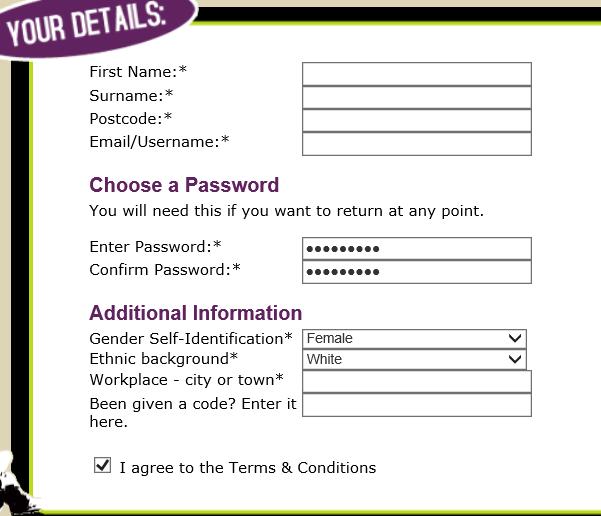
No
It is structured in 3 parts:
- First the participant must choose between a pair of statements, which one applies to him/her or describes him/her best
- Questions in relation to enterprise: what activities the participant is involved in or thinking about (tick the boxes that are relevant).
- Finally, the participant must think if the statements apply to him/her or not. These statements are things that either help to get on or seem to hold back and people are often faced with.
Format of questions
There are 3 types of questions:
- Choose between a pair of statements: 28 questions in both the employer and employee versions
- Tick as many boxes as are relevant to you: 2 questions in the employer version and 4 in the employee version.
- Self-assessment (Likert scale from “definitely applies to me” to “definitely doesn’t apply to me”): 17 questions in both the employer and employee version

46
- Enterprise Catalyst
Survey E-CAT
Examples of questions
There are a number of pairs of statements below on the left and on the right - with four buttons in between. Please read them. You might think the statement on the left applies to you, or the one on the right, or somewhere in between. There will be one that best describes you - click on the button nearest to it. If it isn't a clear choice, click on a button in between.

Tick as many boxes as are relevant to you:

We are often faced with so many things that either help us to get on or seem to hold us back. Please tick the box that indicates the extent to which you think the statements below apply to you or do not apply to you:


47
Survey E-CAT - Enterprise Catalyst
Survey E-CAT - Enterprise Catalyst
Feedback or report given
5-7 page personalised report summarising attitudes towards enterprise which includes:
• Enterprise fuel: Motivation and Drive, Capacity to SelfDetermine, Willingness to Learn
• Personal enterprise style
• Encouragers and barriers to enterprise
• Preferred team role
• Personal learning and thinking styles (schools/colleges only).
The test can be downloaded in a pdf version:


48
Survey
Validated instrument s or results obtained
Over 200,000 people have now completed this self-assessment which provides a comprehensive baseline and benchmark to track the progress and impact for Groups and Cohorts and provide an evidence base of the impact of enterprise interventions.
Other The results are saved and once the user logs in again, the following options appear:
- Complete the test again (only after 24 hours)

- Compare your results with other users with similar results and see what they have done
- View your previous test results


Internal Notes -

49
E-CAT - Enterprise Catalyst
4.2.7. BDC Entrepreneurial Potential Self-Assessment
Survey Entrepreneurial Potential self-assessment
BDC Entrepreneurial potential self-assessment Test
Website Self-assessment, test your entrepreneurial potential | BDC.ca
Who is behind the test
BDC (Business Development Bank of Canada and the financial institution devoted to Canadian entrepreneurs.)
Target Not specified (any entrepreneur or student). Professional context.
Aim “Find out if you have the aptitude, motivation and drive to run your own business.”
Taxonomy or competenc e framework
Several versions of the test
Not found
No
Time 10’ estimated
Number of questions (items)
50
Instructions Tips given at the beginning of the test (e.g., Don’t think too long, There are no right or wrong answer, your honest opinion is what counts). Estimated time and number of statements provided.
Prequestions No
Postquestions
The last part of the questionnaire (section 6, questions 51 to 54) asks personal details such as age, gender, if you have ever worked for yourself and your occupation/profession:

50
Survey Entrepreneurial Potential self-assessment
BDC Entrepreneurial potential self-assessment Test

Dimensions or structure of the test
Format of questions
Examples of questions
Not clear structure. Items are not sorted.
• Self-assessment (Likert scale): 50
Likert scale:

51
Survey Entrepreneurial Potential self-assessment
BDC Entrepreneurial potential self-assessment Test
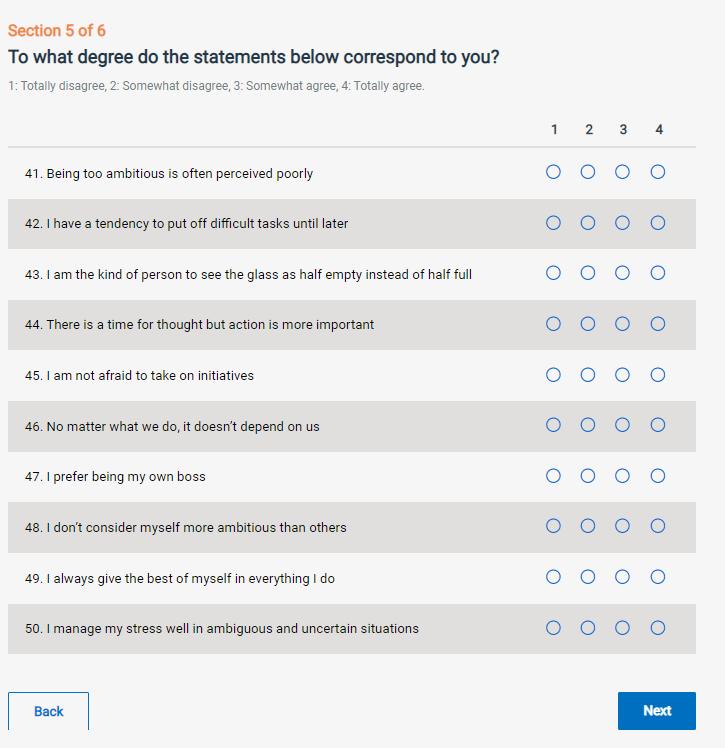
Feedback or report given
Yes, the results are displayed with blue horizontal bands, and a red vertical band shows the mean score of entrepreneurs, so if the horizontal exceeds the vertical range it means your results are above the average:
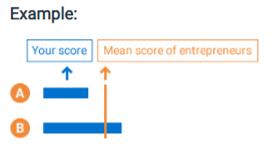

52
Survey Entrepreneurial Potential self-assessment
BDC Entrepreneurial potential self-assessment Test

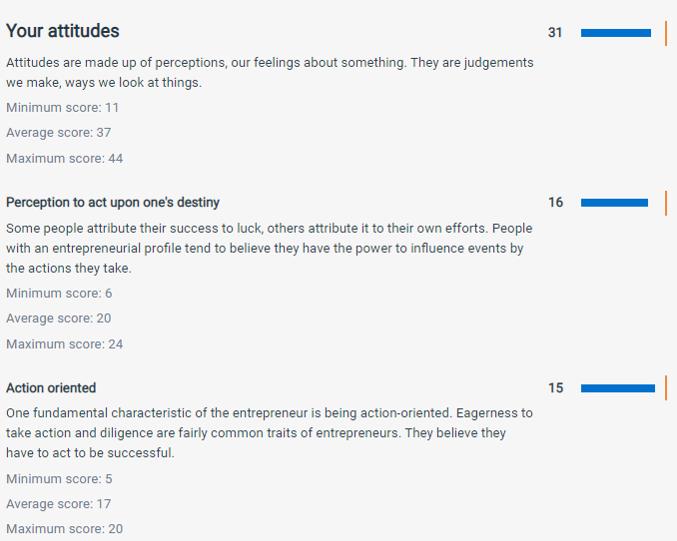
Validated instruments or results obtained
Details not found. In the results test there is the following note:

Other The BDC offers free business advice for entrepreneurs.
Internal Notes -

53
4.2.8. Entrepreneurial Potential and Innovation Competences
EPIC
Survey Entrepreneurial Potential and Innovation Competences (EPIC)
Website https://heinnovate.eu/en/user/sign-in?destination=en/epic/dashboard User guide: https://heinnovate.eu/sites/default/files/202109/EPIC_user_guide_0.pdf
Who is behind the test
EU funded project EEEPHEIC (Evaluation of Entrepreneurship Education at Higher Education Institutions).
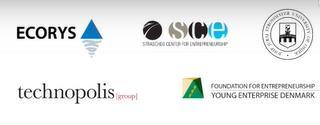
Target The online tool provides teachers with quick overall feedback on their course, students with quick individual evaluations.
Aim The focus of EPIC is on measuring entrepreneurial competencies. The Entrepreneurial Potential and Innovation Competences (EPIC) course assessment tool was designed to help educators to measure the effectiveness of their entrepreneurship courses. It can be used to assess the skill and competence development of participants in different entrepreneurship courses, modules, summer schools, bootcamps or training programmes. The EPIC tool allows you to use predefined sets of questions or tailor the questionnaires to suit your entrepreneurship course the best.
Taxonomy or competenc e framework
Several versions of the test
EntreComp Framework (EU, 2016). The model divides competences for Entre- and Intrapreneurship into three main areas: "Resources", "Into Action" and "Ideas & Opportunities".
A predefined test can be chosen, but the user can also design the set of questions or tailor the questionnaires that suits the entrepreneurship course the best (as a teacher). There are 3 types of predefined tests:
1. Entrepreneurial mindset assessment - with a focus on creative, collaborative and leadership competences. This assessment is suitable for courses that do not focus on venture creation.
2. Readiness for business creation assessment – with a focus on entrepreneurial intentions and entrepreneurial competences

54
Survey Entrepreneurial Potential and Innovation Competences (EPIC)
that are important in the early stages of a venture creation process.
3. Venture creation potential assessment – with a holistic focus on venture creation, including enterprising behaviours and entrepreneurial competences important to all stages of a venture creation process.
Time Depends on the test. Predefined tests templates take between 19 minutes to 29 minutes to complete.
Number of questions (items)
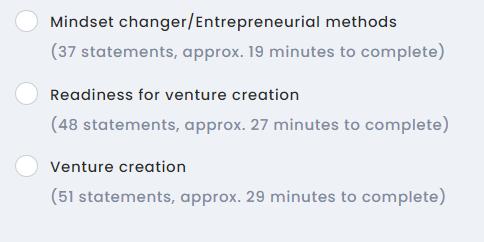
Instructions No tips given, only instructions on time, statements, aim of each template and the possibility to design it your way toadapt to the courses. At the start a message will appear stating that the preview page is what students will be presented when invited to complete the assessment:
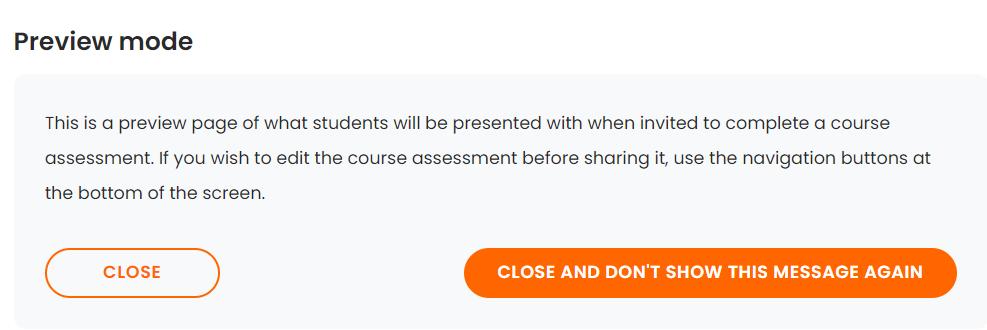
Prequestions No
Postquestions No

55
Survey Entrepreneurial Potential and Innovation Competences (EPIC)
Dimensions or structure of the test
The structure is as follows:
- Entrepreneurial competences
- Entrepreneurial intentions and attitudes
- Entrepreneurial mindset and enterprising behaviours
- Entrepreneurial scenarios
Format of questions
Examples of questions
• Self-assessment (numeric from 0 to 10 scale and before and after the course):
- Entrepreneurial competences:25 questions
- Entrepreneurial intentions and attitudes: 4 questions
- Entrepreneurial mindset and enterprising behaviours: 12 questions
-
• Cases (order the statements from most relevant to least relevant in each case):
- Entrepreneurial scenarios: 5 cases
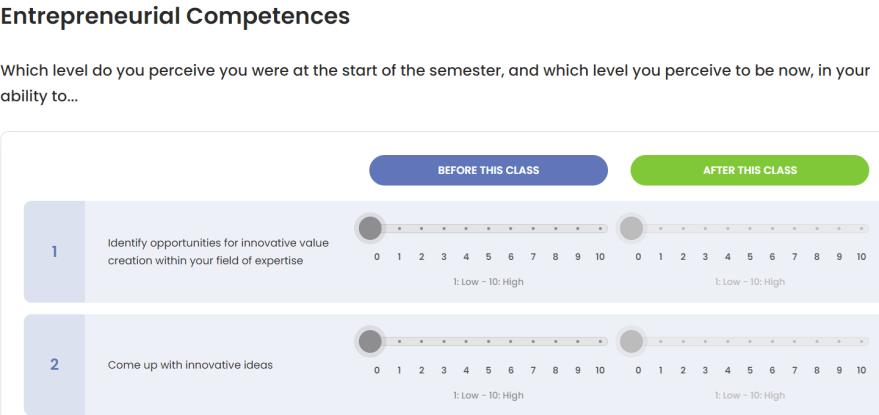


56
Feedback or report given

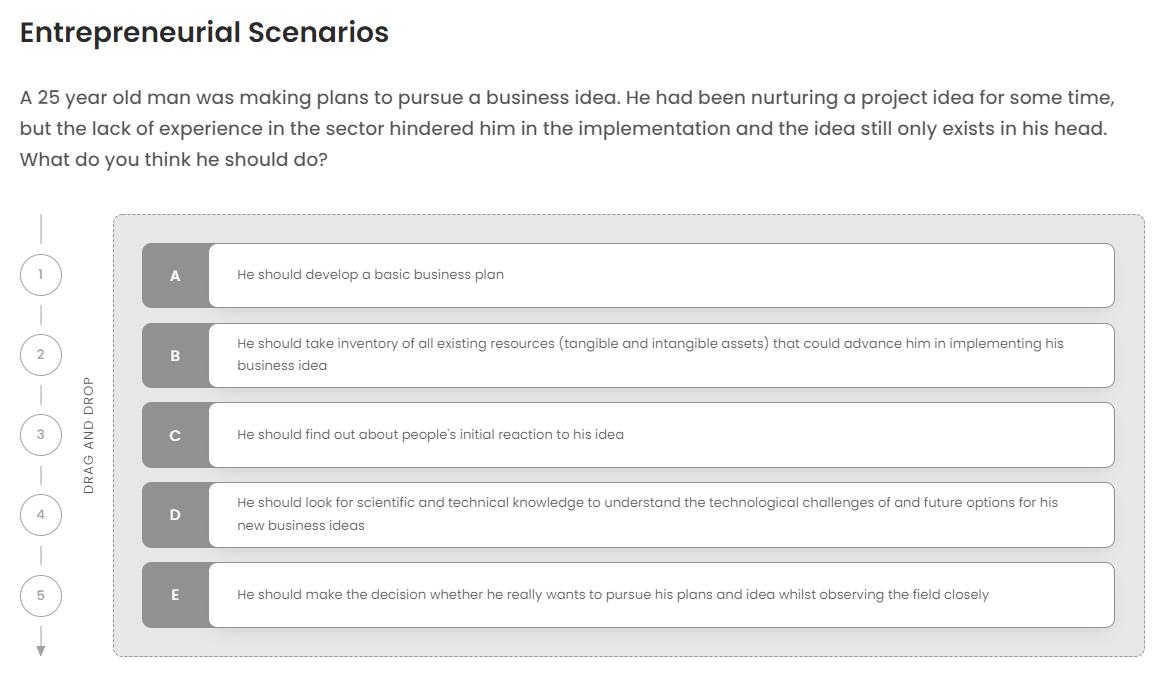
Example of test created: https://heinnovate.eu/en/epic/start-courseassessment/24a7bf8a95cdc918bc39
Once you complete the test you can see the results in an excel file:

57 Survey Entrepreneurial Potential and Innovation Competences (EPIC)
Survey Entrepreneurial Potential and Innovation Competences (EPIC)
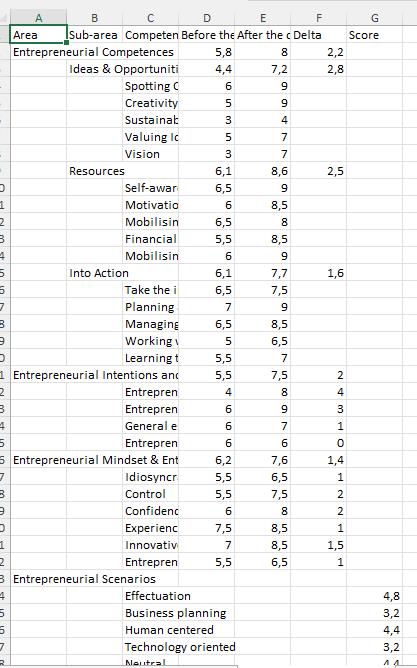
In the website the results can be seen in the account with graphs:

58
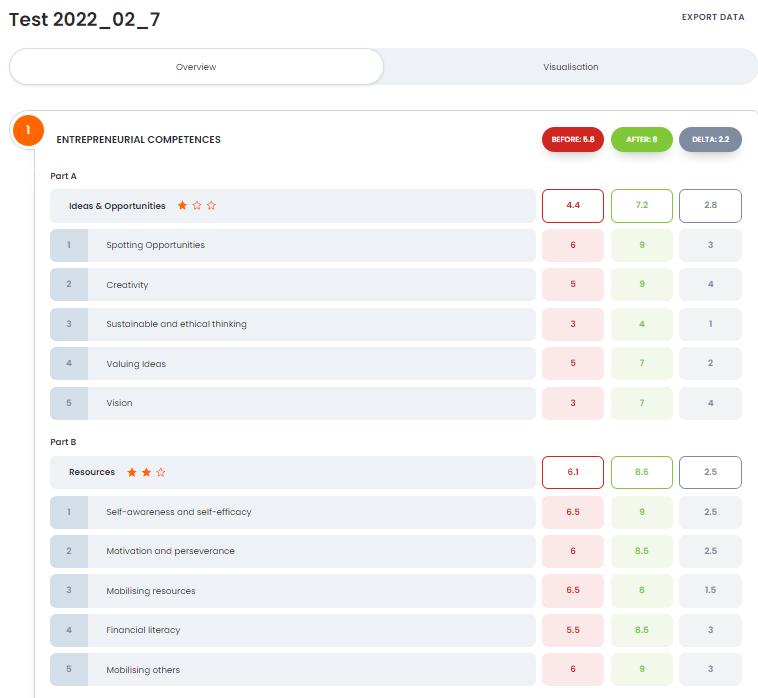

59 Survey Entrepreneurial Potential and Innovation Competences (EPIC)
Survey
Entrepreneurial Potential and Innovation Competences (EPIC)

Validated instruments or results obtained
Other -

60
Survey Entrepreneurial Potential and Innovation Competences (EPIC)
Internal Notes
4.3. Insights
As follows, we provide a summary of the different aspects that we analysed with the previous tools. The summary is grouped under the different research questions stated previously:
1. What are the entrepreneurial assessment tools listed in the literature and/or used for relevant educational and business organizations available online?
2. Are the entrepreneurial assessment tools well-founded on a given competence framework?
3. What is the target group of the assessment tool (entrepreneurs/students/employees…)?
4. What are their characteristics in terms of dimensions of the test, number of questions, type of questions, and expected time to complete the survey?
5. What are the complementary features of the assessment tool, in terms of instructions provided to the participant, design of the test, and feedback given?
4.3.1. List of tools
We analysed eight competence assessment tools in depth. These were the tools that were more related to entrepreneurial competence assessments and were found available online. Most of the tools that we accessed were developed in educational institutions and sometimes, in the framework of European funded projects. Some of the tools were not accessible after the project was completed. Other tools are also developed by consulting companies aiming at providing tailored coaching or training services.
Within the base of the eight competence assessment tools that we reviewed, four of them (50%) are developed by or for educational institutions (BII, Get2Test, MTEE, EPIC) and the remaining four (50%) are developed by consulting companies or organisations whose primary target is entrepreneurs (Entrepreneur Scan, EPT, E-CAT).
We also found that most of the tools require registration prior to taking the test and can be done free of charge. This fact allows information to be collected in some cases for statistical studies of the users' profile or allows users to access their results.
4.3.2. Framework foundations of assessment tools
One of the most interesting questions of our analysis is whether the competence assessment tools are related to competence frameworks and whether they are well founded in research studies.

61
-
The Entrepreneur Scan is based on the Entrepreneur Competence Model (ECM), which is the result of research conducted and contains four essential components:
• Motivation (why do you want to become an entrepreneur?)
• Personal characteristics (who you are as entrepreneur): traits such as achievement, autonomy, power, social orientation,self-belief, perseverance, risktaking, pioneer thinking style, salesperson thinking style, manager style, specialist thinking style.
• Qualities or abilities (what you do well): motivating, interpersonal and communication skills, planning and management, financial management, market orientation, creativity and innovation and flexibility.
• Knowledge and experience (what do you know): organization, people, finance and pricing, and market demand and supply.
The Berkeley Innovation Index (BII) measures the innovation index and six subtraits coming from the entrepreneurial mindset of the Berkeley Method of Entrepreneurship. These are:
• Trust: Learn to trust others.
• Resilience: Accept failure. Analyse, adapt and repeat.
• Diversity: Diversity the networks, connect to people (social capital).
• Belief: self-efficacy.
• Perfection: avoid perfectionism.
• Collaboration: balance between collaboration and competition.
The index also measures five layers of innovation in the fields of:
1. Strategy and leadership
2. Innovation culture from an organisations’ viewpoint
3. Organisational operations and measures across functions
4. Mindset: innovation DNA of people
5. Tactical measures.
The Entrepreneur Profile Test (EPT) is based on a theory of entrepreneurial profiles, according to research performed by the authors:
• Starter
• Serial
• Innovator
• Professional
• Lifestyle-entrepreneurs
• Work-style
The test gives a score to how close the participant is to one of the archetypical profiles.
The GET2 Test for enterprising potential measures the readiness and drive to start a new venture. It is based on the identification of the key characteristics of entrepreneurial people associated to their behaviour and entrepreneurship itself. The key entrepreneurial characteristics used are:
• Motivation, characterized by a high need for achievement and for autonomy.
• Creative tendency
• Calculated risk-taking

62
• Internal locus of control
The results of the test provide scores for each of these dimensions.
The Measurement Tool for Entrepreneurship Education (MTEE) is targeted to teachers, and the aim is that the teachers measure their performance as teachers of entrepreneurship. The instrument EntreCompEdu SAT serves as a reflection tool that provides feedback and helps teachers understand in which areas they can develop their entrepreneurial education skills. The framework is based on the following dimensions (https://entrecompedu.eu/framework/) :
• Professional knowledge and understanding of entrepreneurial education
• Planning and organizing entrepreneurial learning environments
• Teaching and training
• Assessment
• Professional learning
This framework is not comparable to the other frameworks, since it is oriented towards assessment of entrepreneurial teaching.
The Enterprise Catalyst (E-CAT) group the items of the test in several categories or factors:
• Enterprise fuel: motivation, drive, capacity to self-determine and willingness to learn.
• Entrepreneurial intentions: awareness, feasibility, desire and self-efficacy towards entrepreneurship
• Entrepreneurial capacity: self-confidence, skills and social support networks.
• Engagement in entrepreneurial behaviours: participation in current enterprise activities.
• Engagement in entrepreneurial learning: interest and participation in enterprise educational activities.
• Entrepreneurial style: attitudes towards seeking opportunities, managing risk, exploring new ideas.
The EPIC tool is based on EntreComp Framework (EU, 2016). The model divides competences for Entre- and Intrapreneurship into three main areas: "Resources", "Into Action" and "Ideas & Opportunities". A predefined test can be chosen, but the user can also design the set of questions or tailor the questionnaires that suits the entrepreneurship course the best (as a teacher). There are 3 types of predefined tests:
1. Entrepreneurial mindset assessment - with a focus on creative, collaborative and leadership competences. This assessment is suitable for courses that do not focus on venture creation.
2. Readiness for business creation assessment – with a focus on entrepreneurial intentions and entrepreneurial competences that are important in the early stages of a venture creation process.
3. Venture creation potential assessment – with a holistic focus on venture creation, including enterprising behaviours and entrepreneurial competences important to all stages of a venture creation process.

63
As a summary, we observe that every assessment tool has developed their own understanding of the required entrepreneurial competences, based mostly on the authors’ own research. The only exception is EPIC, which uses EntreComp as a reference framework of entrepreneurial competences. However, this test does not provide details of the matching between EntreComp and the survey. Moreover, it allows for some flexibility in the choice of dimensions to measure (i.e., entrepreneurial mindset, readiness for business creation and venture creation potential). Therefore, there is a great variety of tools and theoretical frameworks. This great variety comes from different understandings of what entrepreneurship entails and what competences are relevant for entrepreneurship. The lack of common frameworks makes comparison between these surveys very difficult. Additionally, validation of the surveys and the frameworks seems to be lacking, which does not help in providing future directions of research leading to better design of surveys.
Regarding the dimensions or factors analysed, there are some common aspects that are included in almost all surveys, such as motivation, self-efficacy, and creativity. There is a strong focus on the traits of the entrepreneurs, such as the personal characteristics or abilities present in The Entrepreneur Scan or the archetypical profiles of EPT.
4.3.3. Target group
Most of the tools are aimed at students, but some of them are also aimed at other profiles such as entrepreneurs or individuals. Table 6 shows the main target groups of each tool. As it can be seen, the tools that are designed in the context of educational institutions are mainly targeted to students or teachers, while tools developed by companies or consultants target entrepreneurs and organisations.
4.3.4. Design of the assessment tool
We analysed the structure of the different assessment tools, regarding the number of items, estimated time to complete the survey and type of questions of the survey. Table 7 shows a summary of this analysis.
As it can be seen, the surveys tend to be between 5 minutes and 15 minutes, being a version of EPIC tool as long as 29’. The number of items is between 31 and 109. The type of questions is predominantly self-assessment using Likert scales (of 5 levels mostly). Some surveys also use sorting questions to ask about self-assessment

64
TARGET ESCAN BII EPT GET2T MTEE ECAT BDC EPIC STUDENTS × × × × × × TEACHERS × × × ENTREPRENE URS × × × × × EMPLOYEES × × × INDIVIDUALS × × ×
Table 6. Target group of the entrepreneurial assessment tools.
competences or traits. In the EPIC tool, some questions are plotted as potential scenarios and the participant needs to sort the questions according to the best choice for that scenario. Thus, this type of question is not self-assessed. Rather, they test the knowledge of the participant around a particular topic. E-CAT uses questions where the participant can click on multiple boxes according to their fit with how the participant perceives themselves.
Some surveys such as E-SCAN, MTEEE, E-CAT and EPIC use several types of questions in the survey. Additionally, some surveys have some flexibility and they allow the participant to select the profile (as in E-CAT) or the type of features being tested (EPIC tool).

65
TOOL TIME N. TYPE
ESCAN 16’ 109
Self-assessment (Likert scale):93
Sort the answers: 16
EXAMPLE
“I rarely set goals for myself”
Which option is more applicable to you?
1. Someone who enjoys experimenting
2. Someone who works structured.
3. Someone who gladly assists others.
4. Someone who is always right.
BII 10’ 31
EPT 5’ 22
GET2T 10’ 54
Self-assessment (Likert scale)beliefsSituational judgement
“I trust other people”
“How comfortable are you in making decisions under uncertainty in your professional life?” Choose:
1. Uncomfortable
2. Comfortable with 75% of information
3. Comfortable with 30% of information
4. 10%
Self-assessment (sort the answers) I find it most easy:
1. Being sensible.
2. Thinking in several steps
3. To laugh as well as cry
4. Being intuitive
Self-assessment (agree/disagree) I like a lot guidance to be really clear about what to do in work:
• Tend to agree.

66
Table 7. Table 7. Features of the design of the entrepreneurial assessment tools.
TOOL TIME N. TYPE
MTEE 7’ 63
E-CAT 10’ Employee (49)
Employer (49)
Self-assessment (Likert scale):34
Self-assessment (numeric 0-30): 15
Sort the answers: 8
Binary (yes/no): 6
Choose between a pair of statements: 28
EXAMPLE
• Tend to disagree.
In our educational organisation, we have the resources needed to implement entrepreneurship education (Likert 5)
Have you set your goals for entrepreneurship education in your teaching? Yes/No
Choose:
• I find it hard to maintain my energy and self-belief
• I am determined to keep going and work hard.
Tick as many boxes that are relevant to you:
Tick boxes relevant to you (2/4)
Self-assessment (Likert): 17
BDC 10’ 50
Self-assessment (Likert)
EPIC 19’ 37
• Mindset changer/Entrepreneurial methods
o I know what running my own business would involve.
o Running my own business sounds like a good idea.
o My family would think starting my own business was a good idea.
I can make my own decisions (Likert 7)
To what degree do the statements below correspond to you?
• Being too ambitious is often perceived poorly
• I have a tendency to put off difficult tasks until later
• I am the kind of persona to see the glass as half empty instead of half full
Which level do you perceive you were/are (1-10):

67
TOOL TIME N. TYPE
27’ 29’ 48 51
• Readiness for venture creation
• Venture creation
Structured as:
• Entrepreneurial competences
• Entrepreneurial intentions and attitudes
• Entrepreneurial mindset and enterprising behaviours
• Entrepreneurial scenarios
• Cases (entrepreneurial scenarios)
EXAMPLE
Identify opportunities for innovative value creation within your field of expertise
Scenarios:
A 25 year old man was making plans to pursue a business idea […] What do you think he should do? (sort)
A. He should develop a basic business plan.
B. He should take inventory of existing resources that…

68
4.3.5. Complementary aspects of the design
We also investigated how the surveys are implemented in the online platform and thus, what kind of guidance they provide to the participant either before the test or after the test in the form of feedback.
Regarding the instructions provided before the test, some tools provide some tips on how to answer the questions. For example, in Entrepreneur Scan, the following recommendations are given: “Don’t think too long.” “There is no right or wrong answer”). Berkeley Innovation Index also gives similar instructions (“Indicate how you perceive yourself, “There are no right or wrong answers”, “Simply answer honestly”). It is also common to give the estimated time to answer the survey.
Some of the tests provide a very detailed analysis of the results. For example, Entrepreneur Scan provides the entrepreneurial index, as a number from 0 to 100, and compares it with the average answers. Then, they show how this index can be improved after some training, which is how they sell some training and coaching programs. Another example is the Berkeley Innovation Index, which is a value between 0 and 100, and is detailed in subdimensions: trust; resilience; diversity; belief; allocation; collaboration; comfort zone; innovation zone. Generally, the tests that have an inherent structure provide the scores of the participant in every of the dimensions. These aspects are summarised in Table 8.
TOOL INSTRUCTIONS
ESCAN “Don’t think too long.”
“There is no right or wrong answer”
FEEDBACK
Entrepreneurial index (0-100)
Comparison with previous estimation of the participant
Comparison with average answers
Other information on how to improve it (coaching services offered)
BII “Indicate how you perceive yourself”
“There are no right or wrong answers”
“Simply answer honestly”
EPT Instructions on how to answer the survey, by thinking on a particular focus (free-time or job focus).
“Do the test in one sweep without interruption”
GET2T Aim of the test. How to answer it. “Answer quicky and honestly”.
Innovation Mindset Level (0-100)
Score in each dimension: trust; resilience; diversity; belief; allocation; collaboration; comfort zone; innovation zone.
Description of each dimension.
Which archetype fits the most with the participant profile.
A description of the profile.
General enterprising score.
Analysis of subdimensions:
• Need for achievement
• Need for autonomy
• Creativity tendency
• Calculated risk-taking

69
Table 8. Complementary features of the design of the assessment tools.
TOOL INSTRUCTIONS
MTEE Information on registration needed.
E-CAT Information on the format of the statements, how to interpret and answer them.
FEEDBACK
• Locus of control
Chart with values of each dimension.
Scores in each dimension of the test, with detailed analysis of answers.
5-7 page personalised report summarising attitudes towards enterprise which includes:
• Enterprise fuel: Motivation and Drive, Capacity to Self-Determine, Willingness to Learn
• Personal enterprise style
• Encouragers and barriers to enterprise
• Preferred team role
• Personal learning and thinking styles (schools/colleges only)
The results can be downloaded in a pdf document.
BDC “Don’t think too long”
“There are no right or wrong answers”
Estimated time and number of statements.
EPIC Time estimated, number of statements, aim of the survey. Availability for customisation.
Scores in each dimension compared with the average of respondents, such as:
• Your attitudes
• Perception to act upon one’s destiny
• Action oriented
Results in an excel file, grouped by dimensions:
Competences
• Ideas & opportunities
• Resources
• Into Action
Entrepreneurial Intentions
Entrepreneurial Mindset and Enterprising Behaviours
Entrepreneurial Scenarios
TOOL INSTRUCTIONS
ESCAN “Don’t think too long.”
“There is no right or wrong answer”
Feedback
Entrepreneurial index (0-100)
Comparison with previous estimation of the participant
Comparison with average answers
Other information on how to improve it (coaching services offered)

70
TOOL INSTRUCTIONS
BII “Indicate how you perceive yourself”
“There are no right or wrong answers”
“Simply answer honestly”
EPT Instructions on how to answer the survey, by thinking on a particular focus (free-time or job focus).
“Do the test in one sweep without interruption”
GET2T Aim of the test. How to answer it. “Answer quicky and honestly”.
FEEDBACK
Innovation Mindset Level (0-100)
Score in each dimension: trust; resilience; diversity; belief; allocation; collaboration; comfort zone; innovation zone.
Description of each dimension.
Which archetype fits the most with the participant profile.
A description of the profile.
MTEE Information on registration needed.
E-CAT Information on the format of the statements, how to interpret and answer them.
General enterprising score.
Analysis of subdimensions:
• Need for achievement
• Need for autonomy
• Creativity tendency
• Calculated risk-taking
• Locus of control
Chart with values of each dimension.
Scores in each dimension of the test, with detailed analysis of answers.
5-7 page personalised report summarising attitudes towards enterprise which includes:
• Enterprise fuel: Motivation and Drive, Capacity to Self Determine, Willingness to Learn
• Personal enterprise style
• Encouragers and barriers to enterprise
• Preferred team role
• Personal learning and thinking styles (schools/colleges only)
The results can be downloaded in a pdf document.
BDC “Don’t think too long”
“There are no right or wrong answers”
Estimated time and number of statements.
Scores in each dimension compared with the average of respondents, such as:
• Your attitudes
• Perception to act upon one’s destiny
• Action oriented

71
TOOL INSTRUCTIONS
EPIC Time estimated, number of statements, aim of the survey. Availability for customisation.
FEEDBACK
Results in an excel file, grouped by dimensions:
Competences
• Ideas & opportunities
• Resources
• Into Action
Entrepreneurial Intentions
Entrepreneurial Mindset and Enterprising Behaviours
Entrepreneurial Scenarios

72
5.Conclusions

The analysis of the assessment tools of entrepreneurial competences was helpful to identify the main features of these tools as well as to detect some particularities. We reviewed eight tools that are available online and we answered these tools by taking the role of a participant. This allowed us to see the design of each assessment tool, beyond the documentation provided by the respective tool, and to evaluate our own experience with the tool.
One of the concerns arising from the analysis is the variety of tools and dispersity of approaches. This is probably due to the lack of the identification of a given framework of entrepreneurial competences. Only the EPIC tool uses EntreComp for the assessment of entrepreneurial competences, but not in other parts ofthe survey that measured entrepreneurial intentions, readiness to start-up or enterprising behaviour. There are however many common factors among the tools, such as motivation, drive, self-efficacy, orientation towards action, although they are sorted and grouped under different categories. Most of the tools depart from a tailored framework of entrepreneurial competences which comes from previous research on the topic, although what research and how it was conducted are not always provided in the description of the tool.
There is also lack of validation of these surveys. This means that the dimensional structure of the tool and the number of items may need further refinement. Additionally, the surveys can only provide rough estimates of the capacities of an individual related to entrepreneurship. Some of the surveys have collected a high number of answers and then, they are able to compare the participants’ results with the average population in their general score and in each of the subdimensions. Although this might be informative, the participant should be aware that the mean score of all other participantsmight not be relevant if the answers have high variability, and this information is normally not provided. Additionally, such comparisons should be made with similar target groups (i.e., by age, educational background or gender), but this is not provided either. Surveys validation may be available in research conducted by the authors, which might be published in literature, even at later dates than the release of the survey. Thus, as future research of this work, we could search whether there is such research published in literature.
Most of the assessment tools that we reviewed use self-assessment statements, where the participant perceives herself as having a particular trait, skill or knowledge to some degree, often via a Likert scale. With this type of question, there is the risk that participants do not answer honestly, since it is well-known that biases can influence the participants’ answers (e.g., the willingness to present a positive image towards oneself or towards others). To prevent such biases, the assessment tools provide some tips such as “answer quickly”, “do not think too long”, “there are not right or wrong answers” and “answer honestly”. But this might be not enough to prevent optimistic biases.
All the assessment tools show the results and feedback to the participants in the form of a general score and, if applicable, a score for several subdimensions of the survey, plus comprehensive explanations. This is found to be a good practice in many aspects. First, the participant gets feedback on their entrepreneurial scores, although it might not be very precise due to the lack of survey validation and potential biases. A second benefit for the user is that she is able to understand the factors of the assessment tool, such as in “Ideas and Opportunities”, “Resources” and “Into Action”, in the case of EPIC. This allows the user to reflect

73
on the dimensions of the entrepreneurial activity and might help the participant identify her strengths and weaknesses.
In summary, more research needs to be conducted on assessing entrepreneurial competences by identifying a common framework of entrepreneurial competences, as proposed under the EntreComp framework, and designing and validating the corresponding survey. Standardization and normalisation to different target groups of such tools, as done in the field of psychology, would help advance the current understanding of the entrepreneurial capacities of individuals.

74
6. References

Bacigalupo, M., Kampylis, P., Punie, Y., & Van den Brande, G. (2016a) EntreComp: The entrepreneurship competence framework. Publication Office of the European Union, 10, 593884.
Bacigalupo, M., Kampylis, P., McCallum, E., & Punie, Y. (2016b). Promoting the entrepreneurship competence of young adults in Europe: towards a self-assessment tool. In L. Gómez Chova, A. López Martínez, I. Candel Torres (Eds.), ICERI2016 Proceedings 9th International Conference of Education. Seville, Spain.
Berkeley Innovation Index (2022). https://innovationindex.berkeley.edu/ Business Development Bank of Canada (BDC). (2022). https://www.bdc.ca/en/articlestools/entrepreneur-toolkit/business-assessments/self-assessment-test-yourentrepreneurial-potential
Caird, S. (2022). GET2 test. http://www.get2test.net/
Dickson, P., Solomon, G.T., Weaver, K.M. (2008). Entrepreneurial selection and success: does education matter? Journal of Small Business and Enterprise Development, 15(2), 1462-6004.
https://doi.org/10.1108/14626000810871655
Fonden for Entreprenenorskab (s.d.). An EPIC literature review. Available at https://eng.ffeye.dk/media/791530/an-epic-literature-review-inkl-forside.pdf
Entrepreneur Scan. (2022) https://entrepreneurscan.com/blog/skills-abilities-knowledgecompetencies/
European Commission. (2012). Entrepreneurship 2020 Action Plan: Reigniting the Entrepreneurial Spirit in Europe, 1-18.
Heinonen, J., & Hytti, U. (2010). Back to basics: the role of teaching in developing the entrepreneurial university. The International Journal of Entrepreneurship and Innovation, 11(4), 283-292.
https://doi.org/10.5367/ijei.2010.0006
HEInnovate (s.d.). EPIC. Entrepreneurial Potential and Innovation Competences. A course assessment tool. A Guide to using EPIC on HEInnovate
https://heinnovate.eu/en/user/sign-in?destination=en/epic/dashboard Johnson D. (2022). Enterprise Catalyst. https://www.enterprisecatalyst.co.uk/ Lindstrom, S., (2010). Entrepreneur Profile Test. https://entrepreneurprofiletest.com/
LUT University (2020). Measurement tool for Entrepreneurship Education (MTEE). https://eumtee.lut.fi/
Nabi, G., Liñán, F., Fayolle, A.., Krueger, N., & Walmsley, A. (2017). The Impact of Entrepreneurship Education in Higher Education: A Systematic Review and Research Agenda. Academy of Management Learning & Education, 16(2), 277–299.
https://doi.org/10.5465/amle.2015.0026

75
Oikkonen, E., & Pihkala, T. (2014). Entrepreneurship Education in Schools: Empirical Evidence on the Teacher’s Role. The Journal of Educational Research, 0, 1-14. http://dx.doi.org/10.1080/00220671.2013.878301
Ruskovaara, E., T. Pihkala, T. Rytkölä & J. Seikkula-Leino (2010). Studying Teachers’ Teaching Methods and Working Approaches in Entrepreneurship Education. Paper presented at the ESU Conference, Tartu, August 22-28.
Sánchez, J.C. (2013). The Impact of an Entrepreneurship Education Program on Entrepreneurial Competencies and Intention. Journal of Small Business Management, 51(3), 447-465. https://doi.org/10.1111/jsbm.12025
Shook, C. L., Priem, R. L., and McGee, J. E. (2003). Venture creation and the enterprising individual: a review and synthesis. Journal of Management, 29(3), 379–399.
Stenholm, P., Ramström, J., Franzén, R., & Nieminen, L. (2021). Unintentional teaching of entrepreneurial competences. Industry and Higher Education, 35(4), 505-517. https://doi.org/10.1177/09504222211018068
Taatila, V.P. (2010). Learning entrepreneurship in higher education. Education & Training, 52(1), 48-61. https://doi.org/10.1108/00400911011017672

76

http://www.eicaa.eu


mailto:bratzke@univations.de

twitter.com/ EICAAproject


facebook.com/ EICAAproject



The information and views set out in this publication are those of the authors and do not necessarily reflect the official opinion of the European Union. Neither the European Union institutions and bodies nor any person acting on their behalf may be held responsible for the use which may be made of the information contained therein.










GET IN TOUCH WITH US
EICAA Project
Coordinator
Florian Bratzke Univations GmbH
Linkedin.com/company/ eicaaproject/

Nine partners from five EU countries bundle their resources to bring EICAAto success.
































































































